
Brickwrecks
Behind the builds
Pacific Sea Gardens
Indigenous mariculture sites
The Sydney Punchbowls Enigmatic and unique


Brickwrecks
Behind the builds
Pacific Sea Gardens
Indigenous mariculture sites
The Sydney Punchbowls Enigmatic and unique
As our busiest season approaches, I am delighted to say that visitation is returning to a more normal pattern, following the huge disruptions of recent years. With 435,412 onsite visitors, 804,259 visitors to our travelling exhibitions, 286,672 students and teachers in virtual and online courses, and almost one million website visits, we had a remarkable 2.6 million engagements with our visitors and supporters, whether physically or online. What’s particularly rewarding is that this is despite the COVID-19 closure of the site between June and September last year.
As we race towards the end of the year, then sail into 2023, we have an exciting summer period planned. The exhibition Brickwrecks – Sunken ships in LEGO ® bricks, which we developed with the Western Australian Maritime Museum, opens just before Christmas. It will take visitors both young and old into the stories of shipwrecks such as Pandora, Vasa and Titanic
And once again we are part of the Sydney Festival, with an immersive show Shipwreck Odyssey, and the New Beginnings Festival in conjunction with our friends at Settlement Services International. Details for all our activities can be found on the website as well as in this edition of Signals
Summer will also see some big movements at the museum, with HMAS Vampire being dry docked for some much-needed maintenance and Duyfken heading to Hobart for the Australian Wooden Boat Festival.
Inside the museum we have some gems – The Wharfies’ Mural exhibit (thank you to the Maritime Union of Australia), an Endeavour cannon (thank you, NSW Parks and Wildlife) and the wonderful Sydney Punchbowls. This display partners the museum’s 1820s bowl with its companion from the State Library of New South Wales.

We recently welcomed the Seabin Foundation’s Ocean Health Lab to the museum and are excited to see the results of their continual monitoring of rubbish in the harbour. This is their first Health Lab in the world and we are proud to be an integral part of their next phase of ocean science research.
And finally, I would like to pay tribute to our wonderful volunteers, who, in the last financial year, contributed almost 19,000 hours of passionate work.
I am always happy to hear from the museum family about what matters to you, so please, if you have any ideas, drop me a line to thedirector@sea.museum. I may not be able to respond personally to every message, but please be assured, different voices are both welcome and encouraged.
Daryl Karp AM Director and CEO Stephen Schmidt, Fleet Services volunteer. Image Cassandra Hannagan PhotographyThe Australian National Maritime Museum acknowledges the Gadigal people of the Eora nation as the traditional custodians of the bamal (earth) and badu (waters) on which we work.
We also acknowledge all traditional custodians of the land and waters throughout Australia and pay our respects to them and their cultures, and to elders past and present.
The words bamal and badu are spoken in the Sydney region’s Eora language.
Supplied courtesy of the Metropolitan Local Aboriginal Land Council.
Cultural warning
People of Aboriginal and Torres Strait Islander descent should be aware that Signals may contain names, images, video, voices, objects and works of people who are deceased. Signals may also contain links to sites that may use content of Aboriginal and Torres Strait Islander people now deceased.
The museum advises there may be historical language and images that are considered inappropriate today and confronting to Aboriginal and Torres Strait Islander peoples.
The museum is proud to fly the Australian flag alongside the flags of our Aboriginal, Torres Strait Islander and Australian South Sea Islander communities.
Cover A ‘brickscape’ depicting divers on the Pandora wreck site, from the exhibition Brickwrecks: sunken ships in LEGO® bricks. Image courtesy The Brickman Team
2 Sea Gardens across the Pacific
Recording a renaissance in Indigenous mariculture
10 Rediscovered treasures
The magnificent Sydney Punchbowls on display together
16 Team-building Brickwrecks
Creating LEGO® ship models on a grand scale
22 Maritime history prizes
Announcing the winners
26 Young guns and champions
The latest inductees to the Australian Sailing Hall of Fame
30 The Australian Wooden Boat Festival 2023
Head to Hobart in February for a feast of maritime culture
34 The longest journey
Former refugee vessel Tu’ Do embarks on a new stage of its life
42 James Watt
The Scottish maritime artist who recorded the working life of the Clyde
50 Help us preserve HMAS Vampire
Seeking your support for our end-of-year campaign
53 Members news and events
Your calendar of summer events for members and their guests
56 Exhibitions
Our temporary and travelling exhibitions this season
60 Education
Seaside Stories, a new program for people with dementia
64 Collections
How to hide in plain sight, Operation Jaywick style
70 National Monument to Migration
Hundreds of new names added in a joyous ceremony
74 Settlement Services International
The New Beginnings Festival celebrates cultural diversity
76 Readings
Still Alive; Opposing Australia’s First Assisted Immigrants
84 Currents
Seabin Ocean Health Lab; Fishers Lost at Sea memorials

‘One of the most important aspects of restoring these places is restoring people’s relationships with them’
Showcasing an Indigenous mariculture renaissance

Sea Gardens Across the Pacific is a new ‘story map’ that gathers information about Indigenous mariculture practices across the world and emphasises the importance of revitalising these practices for food sovereignty and resilience, writes Samantha Larson.
INDIGENOUS PEOPLES have been stewarding the ocean for thousands of years. This stewardship has appeared in many different forms around the world, all of which represent a reciprocal relationship between humans and the sea rooted in deep place-based knowledge. From eel ponds in Budj Bim, Australia, to octopus houses in Haida Gwaii, Canada, an Indigenous mariculture renaissance is making waves as groups across the Pacific seek to revitalise these ancient techniques and traditions.
For the first time, information about a multitude of Indigenous cultivation practices has been collected into a cohesive online repository. Sea Gardens Across the Pacific: Reawakening Ancestral Mariculture Innovations is a new, interactive, ‘living’ story map that synthesises knowledge about Indigenous aquaculture throughout the Pacific region, including the west coasts of North, Central and South America; the east coasts of Asia, Australia and Aotearoa New Zealand; Oceania; and coastlines in between. The project shows these local initiatives are not one-off projects, but rather pieces of a global story. It’s a story that is being told by Indigenous knowledge holders, and further amplified by diverse collaborators who created the story map. Many ancestral mariculture practices were subverted over time by colonialist attitudes and policies that targeted the erasure of Indigenous cultures and the separation of people from wilderness. As ocean change caused by industrialisation continues to imperil marine resources, reviving ancient practices could help to protect these ecosystems and the people who rely on them today.
An Indigenous mariculture renaissance is making waves as groups across the Pacific seek to revitalise these ancient techniques and traditions
For example, clam gardens – which are typically created by constructing a rock wall in an intertidal zone, thus expanding habitat for clams and other species – can locally reduce the impacts of warming ocean temperatures. Skye Augustine is an Indigenous scholar at Simon Fraser University, Canada, and a collaborator on the new story map. Augustine spearheaded the restoration of clam gardens at two sites in the Gulf Islands of British Columbia. ‘One of the most important aspects of restoring these places is restoring people’s relationships with them,’ she says:
It forces us to re-examine the idea that humans only have negative impacts on our ecosystems, and remember that for millennia we have had positive and reciprocal relationships with the places we belong to, and that we can have those kinds of relationships once again.
Kii’iljuus Barbara Wilson, a Haida matriarch and Indigenous scholar from the Cumshewa Eagle Clan, collaborated with the team to highlight the octopus houses of Haida Gwaii, an archipelago off the coast of British Columbia. She states:
In this time of climate change, it’s really important to acknowledge Indigenous mariculture as conservation and recognise First Nations governance over our land and resources. It’s time to put the library back together and learn about all the things our ancestors did to ensure that there was enough fish and octopus – looking after and respecting the environment. We managed to live in the world for thousands of years without the massive ecological destruction that’s happening now. It’s very much about not taking more than you need.
From left: Larry Raigetal, Keli‘i Kotubetey and Ann Singeo draw in the sand, demonstrating how the beng of Palau would have looked and functioned. Image Momi Afeli
The Gunditjmara people (also known as the Dhauwurd Wurrung) built channels and pools over an area of about 10,000 hectares
01 An eel pond at Mount Eccles (Budj Bim). Image Mertie, licensed under CC BY 2.0
02
Remains of Aboriginal stone eel traps at Budj Bim. Image denisbin, licensed under CC BY-ND 2.0
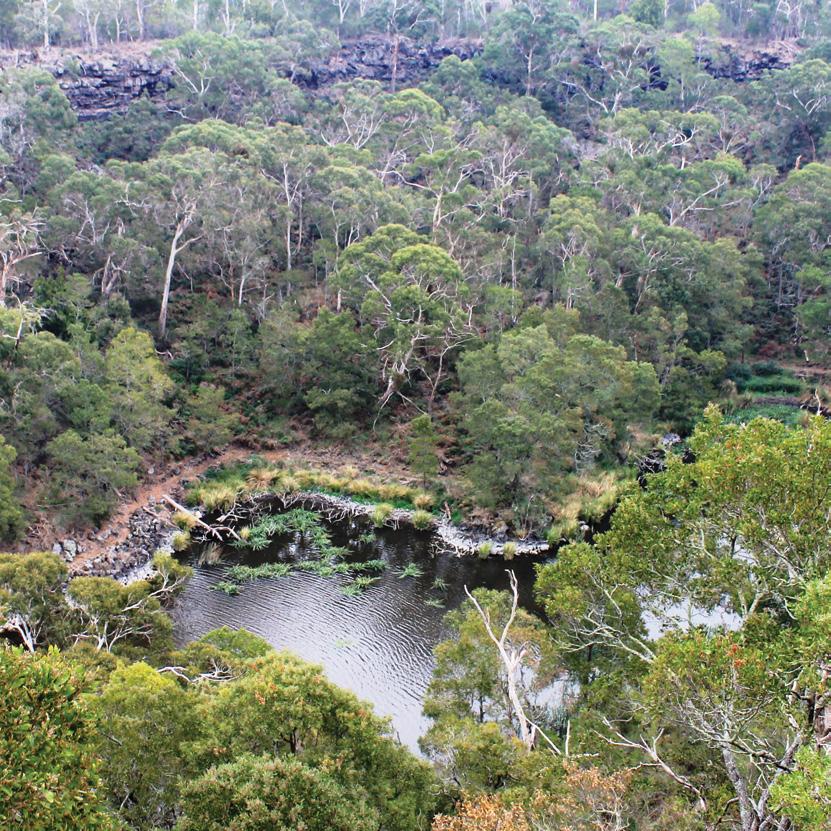

The movement to revive Indigenous aquaculture practices is occurring in modern-day Australia as well.
As described in the story map, the Gunditjmara people (also known as the Dhauwurd Wurrung) built channels and pools over an area of about 10,000 hectares in what is now Victoria, including Budj Bim National Park. This aquaculture system is estimated to have supported gatherings of up to 1,000 people.
After the arrival of European settlers in 1834, however, Lake Condah was drained to increase the land available for livestock grazing, which reduced wetland habitat and rendered the eel traps inoperable. As part of the Lake Condah Sustainable Development Project, the Gunditjmara have put forward a vision for restoring the practice of eel ponds. Their vision is that ‘Gunditjmara people will experience the landscape, engage in eel and fish harvesting using the stone trap systems, and apply traditional knowledge practices in land and water management.’ As the water returns to the landscape, they hope to learn more about the ways in which previous generations cared for and used the land: ‘We will pass what we learn on to the next generation so that traditions and knowledge are never lost again.’ As of now, 24 out of the 82 identified traditional eel traps have been reactivated.
The story map creates a broader frame of reference for these initiatives. ‘It’s so lovely to have a visual representation of these practices, and to be able to see the spatial extent of Indigenous aquaculture and caretaking of coastal environments,’ says Brenda Asuncion, a collaborator on the story map, who co-ordinates a network of Native Hawaiian fishponds with Kua‘āina Ulu ‘Auamo, an organisation that supports traditional practices. ‘They aren’t isolated phenomena.’
Asuncion says that the story map is a way to share knowledge about Indigenous aquaculture, with the potential for an even greater reach to showcase similar community-led efforts around the Pacific.
The story map is one of many collaborations fostered and co-ordinated by the Indigenous Aquaculture Collaborative Network, which is a community of practice consisting of Pacific-region Sea Grant offices; Northwest Tribes and First Nations; Native Hawaiian and Indigenous communities; and organisations and universities working to advance Indigenous aquaculture. In addition to projects and gatherings that take place in virtual settings, the group prioritises opportunities for the community to meet and learn from one another in the real world. In February 2020, the collaborative’s first gathering was held on O‘ahu in Hawai‘i, during which more than 125 participants representing dozens of Indigenous groups from across the Pacific helped to rebuild a seawall to support a loko i‘a (Hawaiian fishpond).
In July 2022, a smaller group of Indigenous aquaculture practitioners gathered for a knowledge exchange in Palau. Local mariculture systems known as beng , in which an obstruction is placed in tidal waters to direct or trap fish (also known as fish weirs), were once commonly used in Palau but now the technique has fallen from use. Participants in the knowledge exchange visited the remnants of a beng in Ngkeklau, and many of the participants shared their own experiences with wall-building from elsewhere in the Pacific Basin. Weaving rocks to enhance habitats for customary foods is one of the many common practices that link unique place-based cultures across the Pacific – from the tidelands of the Swinomish Indian Tribal Community, who are building the first known modernday clam garden in the USA, to the loko i‘a in Hawai‘i. ‘The fellowship of the group was incredible,’ says Larry Raigetal, who is a Pwo master navigator and boatbuilder as well as the co-founder of Waa’gey, an organisation that applies traditional skills and knowledge to addressing the social, economic and environmental challenges faced by the people of Micronesia’s remote islands:
Reviving ancient practices could help to protect these ecosystems and the people who rely on them today

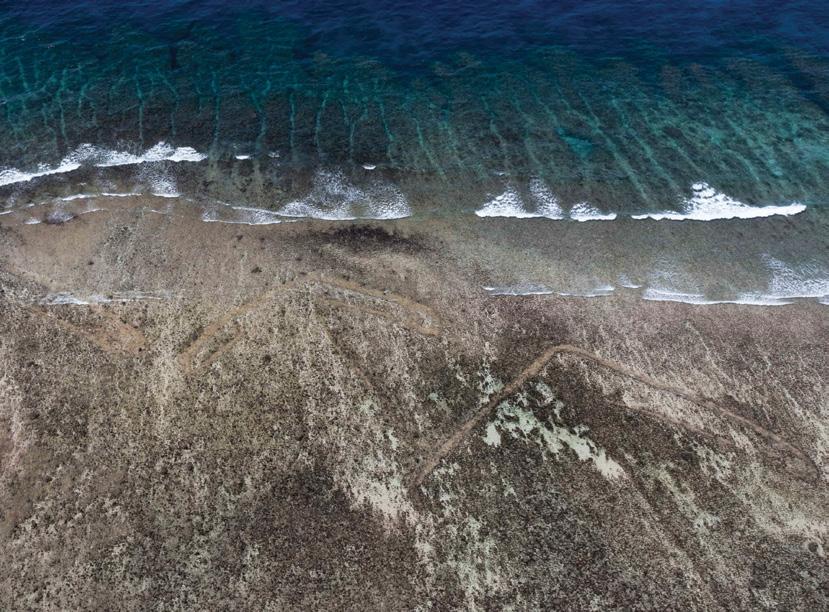
01
Cross-Pacific knowledge exchange participants join Ann Singeo, executive director of the Ebiil Society, to learn more about beng , a traditional mariculture system of Palau. Image Kimeona Kane
02
Palau’s beng had an arrow-like shape. At high tide, fish are directed inside the trap. As the tide recedes, they are trapped inside. The shape of this beng is similar to the aech of Yap, Federated States of Micronesia; Shi hu in Taiwan; and the tidal fish traps of the Salish Sea. Image Reid Endress
It was a great experience, one that sends us off to the different places we are now. I think the momentum that took us from Palau is ongoing. When there is no wind and we need to get somewhere, we paddle while chanting – and the current will take us home. Whether sailing or drifting, we need to be continuing to share this knowledge.
With this momentum, the Ebiil Society is reviving the Ngkeklau beng for community food-fishing rooted in Palauan cultural heritage. ‘We’re hoping we will be able to add our beng to the growing sea garden map,’ says Ann Singeo, the Ebiil Society’s executive, who hosted the knowledge exchange.
The idea for the story map began when Anne Salomon, a marine ecologist at Simon Fraser University, was told by renowned fisheries scientist Daniel Pauly that she could elevate the recognition of the importance of clam gardens by placing them within a global context. ‘These innovations have been present for thousands of years, but much of the world doesn’t know about them,’ Salomon says. She introduced a synthesis and analysis of Indigenous mariculture into her graduate class on social–ecological resilience, and her students came up with the idea of an interactive story map.
As part of the class, students attended the Indigenous Aquaculture Collaborative Network’s gathering in Hawai’i and took part in the restoration of the fishpond. ‘What was so powerful there was the energy, momentum, and the sense of community that flowed from taking part in the revitalisation of that practice,’ says Heather Earle, who co-led, designed and created the story map. ‘As we’ve worked with practitioners, knowledge-holders and researchers across the Pacific to compile this map, we’ve seen that same energy and momentum again and again.’
Salomon reached out to Melissa Poe, who co-ordinates the Indigenous Aquaculture Collaborative Network. Poe immediately saw the potential: ‘These features exist worldwide. If people better understood their diversity, functionality and extent, I’m convinced that more communities would be empowered to restore them.’
While both Salomon and Poe say the current story map only ‘scratches the surface,’ they believe that publishing this current edition will help bring other practices into the public light. As the conversation around Indigenous mariculture continues to gain traction, and as recognition of the innovation and resilience of these biocultural seascapes grows, the contributors see them as time-tested solutions to some of our most pressing coastal challenges.
In other words, this global perspective can help affirm and push forward the local ones. ‘The power is to first understand that almost the same idea exists across cultures, and that many of the same things are important to these seascapes across the world. For example, the wisdom of the elders is very important,’ explains story map collaborator Jaime Ojeda, who contributed to the story map’s piece on corrales de pescas – a practice that Ojeda’s grandmother, a Mestizo–Chiloté elder, grew up with in Patagonia. ‘In terms of the past, but also in terms of right now. Sometimes people think this is history –it has happened. Part of the power is for people to see, oh, this is happening. In many places, this is happening.’
To explore the story map, see seagardens.net
Samantha Larson is the science writer at Washington Sea Grant.
For the next six months, visitors to the museum will have a rare opportunity to see two treasures of early Sydney on display, reunited for only the second time in their history. By Dr Kimberley Webber.
IN ABOUT 1820, someone familiar with Governor Lachlan Macquarie’s Sydney commissioned Chinese artists in Canton (now Guangzhou) to paint a pair of large punchbowls with panoramic views of Sydney Cove. One was to show the view from the east, and the other from the west. The punchbowls are a ‘harlequin pair’ – similar but not identical – and there is some overlap between the two panoramas.
The commissioner must have provided the artists with engravings or drawings of the relatively new town, as the results were surprisingly accurate. A highlight of this exhibition, which features both bowls, is the use of large-scale digital imagery to reveal the fine details of the panoramas and to identify significant buildings.
First Nations people are present on the foreshores at Tallawoladah (Miller’s Point) and Tubowgule (eastern Circular Quay), in fishing canoes on the harbour and in the centrepiece inside each bowl. This was intended as a surprise reveal once the contents were drunk. Depicting a traditional Aboriginal marriage ceremony, it may have been meant to convey to a European viewer the pitfalls of marriage. Historian Elizabeth Ellis OAM has traced the image to an 1802 drawing by Nicolas-Martin Petit, an artist on Baudin’s expedition of 1800–1803, who made some of the earliest ethnographic studies of Australia’s First Nations.

Although the bowls have been extensively researched, much of their history remains unknown
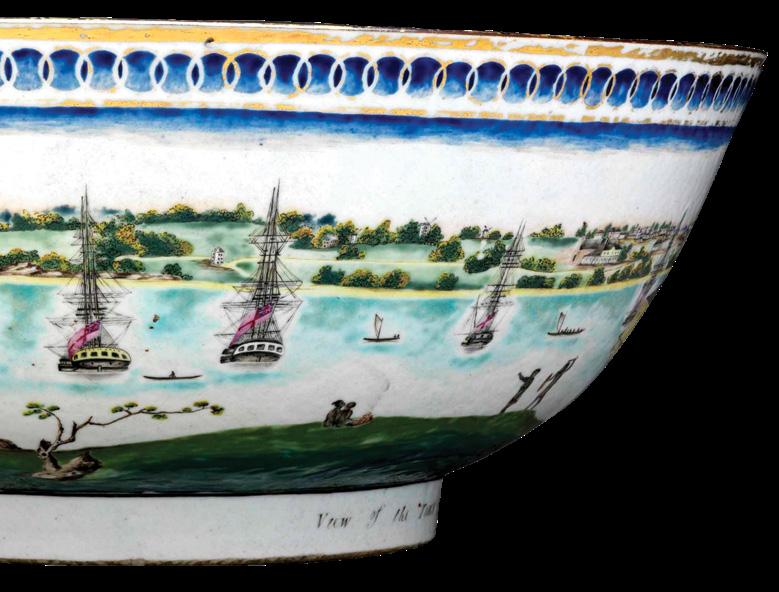
On the museum’s punchbowl, the view is from Dawes Point (now the site of the southern pylons of the Sydney Harbour Bridge). Although the source is unknown, the painters would have drawn upon contemporary engravings; panoramic views were particularly popular at the time.
ANMM Collection 00039838 Gift from Peter Frelinghuysen through the American Friends of the Australian National Maritime Museum and partial purchase with the USA Bicentennial Gift funds
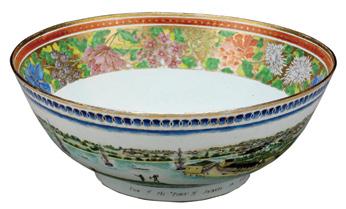


The presence of these figures on the punchbowls is also a reminder of the tragedy inflicted upon Aboriginal people on these once verdant and peaceful harbour foreshores. By the time these images were made, their lands had been taken and their water supply polluted, and many had died following the introduction of European diseases.
Although Ellis has extensively researched the bowls, much of their history remains unknown. Were they commissioned by someone in Sydney and brought back to the colony? Or, as Dr James Broadbent suggests, were they perhaps purchased as souvenirs of New South Wales and never sent here? Adding to the mystery, both turned up in England within a few years of each other.
The ‘eastern’ bowl was found in a London bookshop by William Little in 1926. Recognising the importance of this ‘relic of early Sydney’, he brought it back to Australia and donated it to the State Library of New South Wales.
Six years later, the ‘western’ bowl came to the attention of the National Art Collections Fund in England. The chairman, Sir Robert Witt, wrote to the director of the Art Gallery of New South Wales suggesting that it would be ‘a splendid asset’ for a museum. His letter was referred on to the library, which declined on the basis that it already had a similar bowl.
A view of the town of Sydney in New South Wales ANMM Collection 00039838. Gift from Peter Frelinghuysen through the American Friends of the Australian National Maritime Museum and partial purchase with the USA Bicentennial Gift funds
02
Inside both bowls is the same image of Aboriginal people and the same wide band of traditional flowers, although each bowl is seemingly painted by a different hand.
1
The rear promontory is Mrs Macquarie’s Point, so named as it was a favourite vantage point of Governor Lachlan Macquarie’s wife, Elizabeth.
2
The next promontory is Bennelong Point, where the Sydney Opera House now stands.
3
The large ships fly the British Ensign. Also visible are smaller European sailing craft and two Aboriginal nawi; several Aboriginal people are depicted in the foreground.
4
Between the second and third of the larger British ships, Billy Blue’s Cottage is just visible.
5
In the distance on the eastern shore is Government House, its substantial domain and the residences of senior officers and civil personnel. In December 1817, construction commenced on Fort Macquarie (now the site of Sydney Opera House); there is no sign of it here, suggesting that the artists were copying an earlier image.
6
Dominating the right-hand half of the view is Robert Campbell’s compound. His trading premises were at the bottom of George Street and secured by a large wooden gate (just visible between the two yellow buildings).
7
Robert Campbell’s substantial whitewashed home.
8
A ship is careened in Campbell’s Cove.
9
Campbell’s compound included three acres (1.2 hectares) of lush walled gardens, where white peacocks and emus (not pictured) used to roam.
10
Clearly visible are the boulders and sandstone outcrops that gave this area, The Rocks, its name.
11
Fort Phillip, flying a large British flag, was the main signalling post for the town and was on the site of what is now Sydney Observatory.

The entire panorama of the museum’s bowl, looking from east to west.
The museum’s collection includes an 1820 engraving by W Preston of a similar view to that featured on the punchbowl.
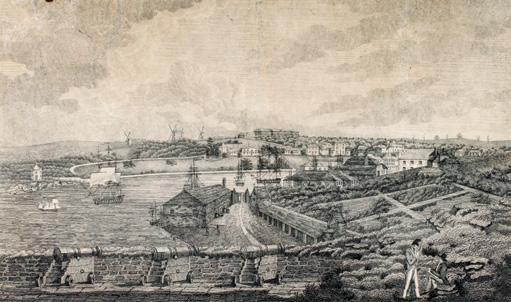

The punchbowls are a ‘harlequin pair’ – similar but not identical –and there is some overlap between the two panoramas

01 The library’s punchbowl bears a monogram, although who it relates to has not been determined.
02 The complete view pictured on the State Library’s bowl. Billy Blue’s hexagonal stone house is prominent.
Images reproduced courtesy of Mitchell Library, State Library of NSW, SAFE / XR 10
1
Government House, a prefabricated structure brought out with the First Fleet as Governor Arthur Phillip’s residence. It shows the various additions that he and his successors made. The site is adjacent to what is now the Museum of Sydney on Bridge Street.
2
The beach forming the head of Sydney Cove would once have been a pristine site for First Nations people, with the Tank Stream flowing into the bay nearby. In 1841 this would be reclaimed to create Circular Quay.
3
The long brown building is the Military Barracks, a substantial complex that surrounded a parade ground, of which a remnant remains today in Wynyard Park.
4
The Dry Store, built in late 1790. It is now Sirius Park.
5
The hexagonal two-storey building in the foreground was built for Governor Lachlan Macquarie’s harbour watchman, the former convict Billy Blue. Born in Jamaica, Blue may have been a freed African–American slave.
6
St Philip’s Church, with its clearly visible tower, was built in 1810 as the first church in the colony. Rebuilt in 1856, it still stands near Wynyard Station.
7 James Underwood’s house. A prominent shipbuilder and merchant, Underwood had arrived as a convict on the Third Fleet, in 1791.
8
The Military Mill was one of 15 windmills built by the government and private individuals. They were in great demand, as convicts and settlers needed their monthly rations of grain ground into flour so they could bake bread and cook porridge, two staples of their diet.
George Street Gaol was the site of public executions in Sydney.
The Commissariat was the main storehouse for foodstuffs and other goods. It stood on the site of what is now the Museum of Contemporary Art.
Fort Phillip was the main signalling post for the town.
12
The large complex of white buildings at the far right of the panorama was owned by Robert Campbell. The youngest son of the Laird of Ashfield in Scotland, he was a merchant who came to Sydney in 1800 after working for a firm of merchants in India. He leased a large portion of waterfront land (close to where the Overseas Passenger Terminal is today) and built a substantial home, wharf and storehouses. 13
A small yellow flag flies over Dawes Point Battery, the first permanent fortification in Sydney.

By then, however, the bowl had been sold to Adaline Frelinghuysen (née Havemeyers) of Philadelphia, USA, who, with her husband, assembled an important collection of Chinese export ware. The bowl was not seen again in public until 1996, when it was included in an exhibition organised by the Peabody Essex Museum, USA, and the Hong Kong Museum of Art. Fortunately, it came to the attention of curators from the Australian National Maritime Museum and in 2006 Peter Frelinghuysen II generously agreed to donate it, with a partial purchase using USA Bicentennial Gift Funds and the support of the American Friends of the Australian National Maritime Museum.
In a remarkable coincidence, just as this display was being planned, Mrs Alison Carr offered to donate her replica Sydney Punchbowl to the museum. In 2014, noted Australian antiquarian dealer Hordern House commissioned a limited series from the same region where the originals were made. As a result, when the library’s bowl is returned in 2023, the replica will take its place, ensuring that visitors can still enjoy these wonderful views of early Sydney.
Dr Kimberley Webber is the museum’s Project Officer –National Encyclopedia of Maritime Objects (NEMO).

All of the components used to build the ship are standard, everyday LEGO® pieces
Despite its singular name, ‘The Brickman’ is actually a team of skilled LEGO® brick artists led by Ryan McNaught (also, slightly confusingly, known as ‘The Brickman’). Together, and in collaboration with the museum’s Creative Producer Em Blamey, they created the stunning models for the Brickwrecks exhibition. Three Brickman team members share some insights into how they did it.
Luke Cini and Rena
BUILD MANAGER LUKE CINI built the stunning model of Rena, a container ship that wrecked on a reef off New Zealand in 2011, spilling oil and cargo and creating that country’s worst maritime environmental disaster. He says:
To begin any LEGO® build, the first step is to research and gather images and inspiration for the project. It is important to have sufficient knowledge of what the subject matter is before beginning any design work. When sourcing imagery for the build, I searched for photos and 3D models that helped tell me what features stood out and made the subject matter recognisable. For example, on the Rena, the containers stood out to me in the photos, so I knew that it was important to represent them well in the build, and gathering enough photos helped put together a more cohesive picture of the build. The 3D model was also a great reference to have – even though we didn’t use it to produce a brick model, we used it for referencing the shaping of the ship.
The next stage was to draw a basic concept of what the finished model would look like. This is a crucial step to get a better understanding of the project. This concept stage enables us to work out what bricks we will be using and how much time we will need to allocate for each part of the build to ensure success. All that was required in this step was a basic sketch of the model, with rough dimensions.
When it came to building the model, we had a flat piece of aluminium that we began the build on. This allowed us to start with a nice, solid, robust base. We then mapped out where the Rena would sit and what pieces would work well with the angle we wanted the ship at. We found that having the ship on an angle of 75 degrees would fit perfectly with the factory LEGO® wedge plates, allowing us to neatly finish the edges of the ship into the water.
We had a lot of fun adding in the small details once the main components of the build were complete. We included a block of cheese, which had fallen from the ship and which we had seen in a video.
Toppling containers, floating debris and an oil spill: the 2011 Rena wreck captured in LEGO®. Image courtesy The Brickman TeamDarren Ballingall and Pandora
Model Maker Darren Ballingall faced the challenge of re-creating the Pandora wreck site accurately enough to allow actual photographs of archaeologists excavating the wreck to be overlaid on the model, using Augmented Reality:
The wreck of HMS Pandora – which sank in 1791–became a large model that utilises special features. This required a lot of co-ordination between the builder and the multimedia experts. Making sure that there was plenty of space for the imagery to appear, and that it could be aligned properly, was one of the more important considerations, and careful planning was needed.
For the layout of the wreck, we used a lot of research that was kindly supplied by the helpful representatives from the Australian National Maritime Museum.
Without these photographs and diagrams, the model wouldn’t have been possible. We like to make models as accurate as we can, so using all of this reference material was essential. We use a special program that imports images and diagrams, so we can change the scale and plan out the size of the LEGO® model. From here it was a matter of building everything to the correct scale. A lot of the Pandora wreck is hidden beneath the sand, so only fragments of the actual ship needed to be made.

The human figures of the divers were a fun and complex challenge
The human figures of the divers were a fun and complex challenge – we needed to make posable human figures to the correct scale and full of accurate detail, as well as making them appear to be floating and swimming under water. One of the hardest things in creating LEGO® models that appear to be floating is being able to support the weight without it looking too much like it’s attached to the base. Luckily the diver models aren’t very heavy and only need one or two supports to keep them steady.
Then the fun parts came at the end – decorating with coral and adding little schools of fish. Fun touches like this really help to set the scene and bring a model to life.
01 A LEGO® diver in a hair-raising situation. The models of the divers are supported on slender transparent rods. 02 LEGO® divers excavate the Pandora wreck site.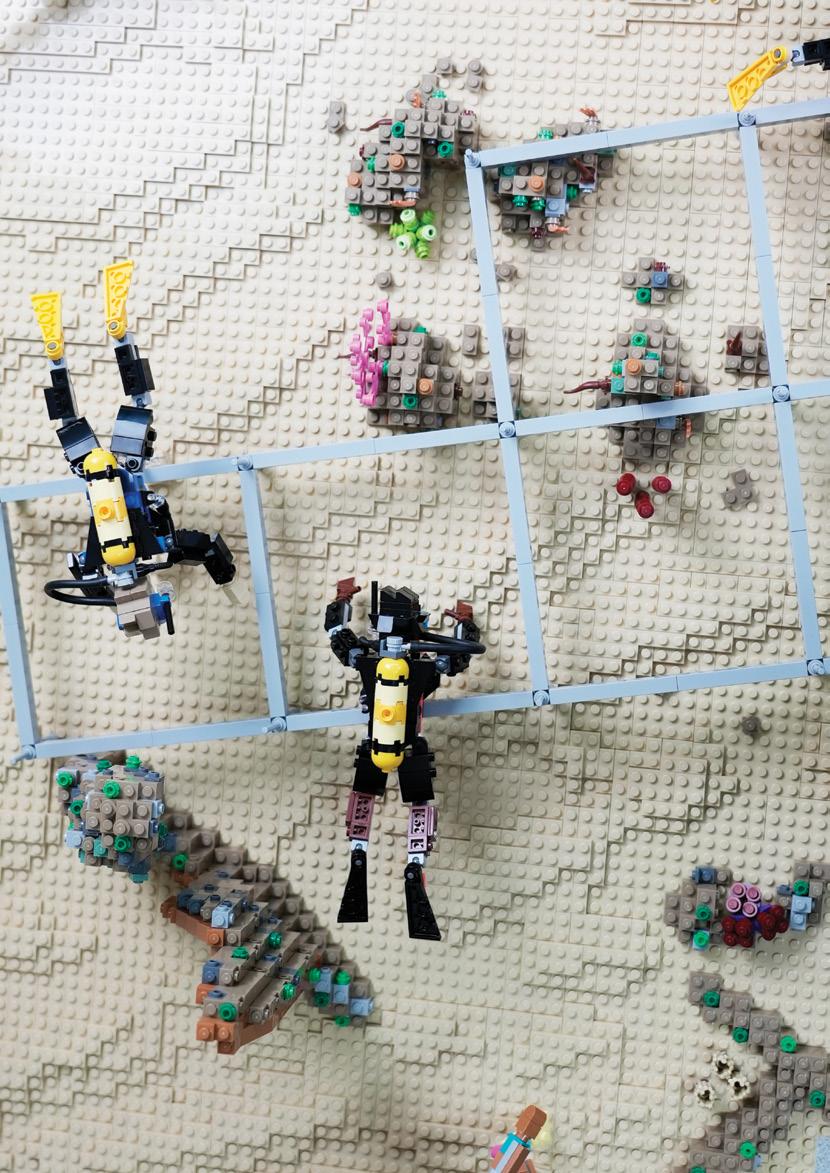
When beginning a model based on history, the first and most important step is research

Liam Tullett and Batavia
Liam Tullett, Model Builder and Team Leader, faced the challenge of building Batavia, one of the most complex models in the exhibition. With its stunning, stark-white, billowing sails, expertly created from thousands of LEGO® pieces, it’s a highlight of the show. Liam says:
The Batavia was a ship built in 1628 by the Dutch East India Company. On its maiden voyage in 1629 from The Netherlands to Batavia (now Jakarta), it was steered off course, crashing and stranding the passengers and crew on islands off the coast of Western Australia.
When beginning a model based on history, the first and most important step is research. Luckily for us, a full-scale replica of the Batavia was built in 1995 and still exists today, so it was very easy to find lots of high-quality images and videos to base our design on. We did a lot of reading about the history of the ship and its voyage – it was a fascinating tale of wreck and mutiny.
To begin the actual build process, we converted a 3D model of the ship’s hull into custom LEGO® software that allows us to edit and view a digital version of the LEGO® model layer by layer, not unlike a CT scan. This requires us to follow that plan, building the model with a hollow interior to use fewer pieces, and to allow a steel skeleton inside the hull and masts to keep the ship strong during its travel as an exhibition piece.
Once the 3D model is finished, the real fun can begin. After building the hull following our plan, it was back to the photos and videos of the replica ship, and accounts of the real thing, to build all of the more intricate details. We used bricks with a groove in the side, typically used to depict brick walls, to simulate the long horizontal planks making up the sides of the ship. We also used thousands of white plates attached sideways to create all the sails on the ship. This technique allows the sails to be a lot stronger, and for them to look full, as if the ship is moving.

01 The Batavia model under full sail. The cutaway gives a glimpse below decks.
02 LEGO® Batavia is as crowded as the real thing.
03
Minifigures making mischief.
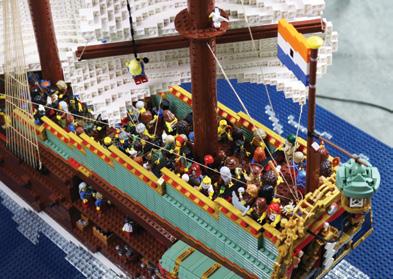
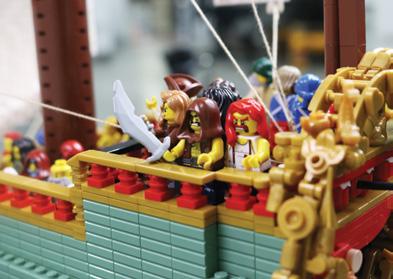
We also used almost all current gold LEGO® elements to re-create the intricate decorative details on the rails and rear of the ship.
All of the components used to build the ship are standard, everyday LEGO® pieces – the only part of the build that isn’t LEGO® is the six metres of twine used to re-create the ship’s rigging! This rigging was more than decorative – it actually helps to stabilise the masts and sails and stops them wobbling when the model is moved.
Many accounts of the ship reported that it was full of passengers and soldiers, so we included more than 200 minifigures packed in over the many decks of the ship, and even one tangled up in the rigging. Posing the minifigures and telling stories with them is always the best part of the build.
Building a model of this scale and scope was a fun challenge, and it was an honour to bring an iconic and historic ship to life using LEGO® bricks.
Brickwrecks – sunken ships in LEGO ® bricks is a new family-friendly exhibition that tells the stories of a number of shipwrecks from around the world, using a unique combination of LEGO® models, hands-on interactives, AV experiences and real shipwreck objects.
As The Brickman himself, Ryan McNaught, says:
‘The Brickwrecks exhibition is the most underwater fun you can have without getting wet!’
Brickwrecks – sunken ships in LEGO ® bricks opens at the museum on 17 December. For more information, see sea.museum/brickwrecks
The Australian Association for Maritime History and the Australian National Maritime Museum are delighted to announce the winners of the 2021 round of two key biennial maritime history prizes.
Anita Herle and Jude Philp (eds), 2020, Recording Kastom: Alfred Haddon’s journals from the Torres Strait and New Guinea, 1888 and 1898, Sydney University Press, Sydney
Frank Broeze Memorial Maritime History Book Prize
THE AIM OF THE FRANK BROEZE Memorial Maritime History Book Prize is to further the study and enjoyment of maritime history in Australia. The winner receives an award of $6,000.
The judges considered the quality of research, the liveliness of the writing, the likely audience appeal and the enduring value of the work as a contribution to maritime history. Overall, it was encouraging to survey the health of Australian maritime history, including works that focused on individuals and families, maritime communities ashore and at sea, vessels and voyaging, and First Nations cultures and their complex relationships with the colonising process.
The four shortlisted titles all satisfied the judging criteria and are recommended to readers, researchers and libraries around Australia. Ultimately, the judges’ decisions were unanimous and we congratulate the winner, extending our commendation to the three runners-up. We thank all authors and their publishers for contributing to the 2021 competition and look forward to entries submitted for the 2023 prize.
The editors present Cambridge zoologist and anthropologist Alfred Cort Haddon’s personal journals of his visits to the Torres Strait, New Guinea and North Queensland in 1888 and 1898. During these trips Haddon gathered an extensive and significant collection of Torres Strait materials, including artefacts and sound and film recordings, all now held in British, Irish and Australian institutions. Haddon realised the importance of his work as perhaps the last opportunity to record traditional customs in the region as they were being affected by colonialism. His private journals give a greater insight into Haddon’s personal views and life in the region at the end of the 19th century. His informal writing style is engaging and readable, in the descriptive manner of a 19th-century traveller’s account. His observations of the many Indigenous, colonial and other characters he meets as he voyages through the region reflect both his excitement when encountering new and valuable information, as well as period prejudices. The book is well footnoted and richly illustrated with Haddon’s sketches and watercolours from his journals, alongside modern photographs highlighting significant items from the anthropological collections mentioned in the text. The authors consulted extensively with both Traditional Owners and Haddon’s family to contextualise the journals, which include modern anthropological reflections and perspectives. This is a high-quality work of enduring value that does justice to the richness of Torres Strait Islander and New Guinea peoples’ culture, spirituality, voyaging, trade and interactions.
Model of a mask, Op le meket
with pearl-shell
Collected Mer, Torres Strait, 1898. MAA Z 9399
Haddon realised the importance of his work as perhaps the last opportunity to record traditional customs in the region
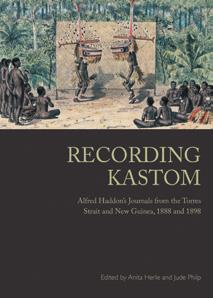
 sarik, made for Haddon.
Painted wood
eyes and goa nuts, string, feathers, shells.
sarik, made for Haddon.
Painted wood
eyes and goa nuts, string, feathers, shells.
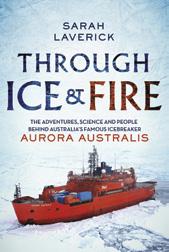
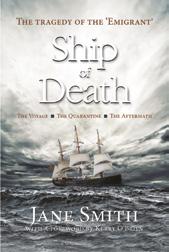
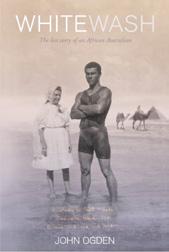
Sarah Laverick , 2019, Through Ice and Fire:
The adventures, science and people behind Australia’s famous icebreaker Aurora Australis, Pan Macmillan Australia, Sydney
Through Ice and Fire relates selected highlights from Aurora Australis ’ 30-year career as the first and only Australian-built Antarctic flagship. The result is an endearing and exciting account of the life of the ship and the people who lived and worked aboard it in extreme conditions, including surviving the dangers of shipboard fires, maritime rescues and running aground. Laverick brings unique insight both as an Antarctic scientist – she describes well the range of Antarctic science programs and the global contribution of the scientific community who worked on the vessel – and as a member of the shipbuilding family who built the ship at Carrington Slipways in Newcastle. Her interviews with key figures among the builders, crew, scientists, voyage leaders and vessel managers give readers a direct insight into all aspects of the workings of the vessel, and of Australia’s Antarctic program. This book exudes the salty tang of the Southern Ocean and will be enjoyed by anyone with an interest in polar science and the history of Australia’s Antarctic research program. No endnotes or footnotes are provided, although sources are listed for each chapter.
Jane Smith, 2019, Ship of Death: the tragedy of the Emigrant : The Voyage – The Quarantine – The Aftermath, Independent Ink, Carindale Ship of Death is a comprehensive account of the tragic voyage of the Emigrant, which sailed from the United Kingdom to Moreton Bay, Queensland, in 1852.
During the seven-month voyage and quarantine period at Dunwich Quarantine Station on North Stradbroke Island, 48 of those aboard would die of typhus fever, including two surgeons. Smith’s in-depth research into many of the passengers, crew and medical staff is a testament to the fates of the people aboard, both those who died and those who survived to make their lives in the colony of Moreton Bay.
Smith contextualises the voyage within the backdrop of wider events that occurred, providing a window into early European settlement of Queensland, immigration and medical practice generally. For example, in assisting the reader to understand the issues surrounding the management of disease, Smith explores the state of British medical education, research and accepted treatments in the mid-19th century. Overall, Ship of Death is an excellent example of how genealogical research can be transformed into an engaging, historically contextualised narrative. The book is well written and researched, with endnotes.
John Ogden, 2020, Whitewash: The lost story of an African Australian, Cyclops Press, Sydney
Whitewash tells the story of George Bernard (Bernie) Showery, a Native American–African–Australian man whose interesting family background and life included being an expert swimmer and lifesaver in the Freshwater Bay Surf Club, fighting in World War I in the legendary 7th Light Horse Regiment, being injured in the war and returning home to become a soldier–settler. In exploring how race and historical events shaped Showery, and in providing context and comparable examples to fill in the gaps, the book explores diverse subjects globally such as racism, slavery, Indigenous rights and beach culture.

Australian Community Maritime History Prize
This prize acknowledges a community-based work that advances the field of Australian local maritime history. The winner receives an award of $2,000.
Winner
Graeme Broxam (ed), 2020, Tasmanian Piners’ Punts: Their history and design, Wooden Boat Guild of Tasmania, Battery Point
This is a valuable contribution to the record of a specific boat type and a maritime industry. The book offers a neat combination of oral history, newspaper research and a survey of surviving piners’ punts. Shaped from fragmentary sources, it is well written and full of evidence, intended to serve as a reference rather than a narrative account. It will be a valuable guide for historic, ethnographic and archaeological studies of small Tasmanian boats and their construction.
Runner up
Mission to Seafarers Victoria, 2020, Harbour Lights –women with a mission 1914–1918, Mission to Seafarers VIC/Wind and Sky Productions, Melbourne
This is a well-made short film about the Mission to Seafarers, historical and contemporary. In 20 minutes it outlines the mission’s role and relevance as a unique community outreach service for mariners who came ashore away from home. The production is well scripted and accessible, narrating the forgotten contribution of women to the welfare of merchant sailors during World War I.

Judges
Dr Ross Anderson, Curator, Maritime Heritage, Western Australian Museum and President, Australian Association for Maritime History
Dr Peter Hobbins, Head of Knowledge, Australian National Maritime Museum
Dr Wendy van Duivenvoorde, Associate Professor of Maritime Archaeology, Flinders University
Mission to Seafarers volunteers preparing and serving a meal in the mission’s kitchen to visiting seafarers.
Nominations are now invited for the 2023 round of prizes, which total $10,000. For criteria and how to nominate, see www.sea.museum. maritimehistoryprizes Nominations close on 30 March 2023.

In 2009, at the age of 16, Jessica Watson become the youngest person to sail solo non-stop around the world
Sixteen-year-old Jessica Watson aboard Ella’s Pink Lady rounding the southern tip of Tasmania after six months at sea. Image Sam Rosewarne/ Newspix
The latest inductees to the Australian Sailing Hall of Fame include the youngest ever, Jessica Watson OAM, at 28 years of age. Joining her are Mathew Belcher OAM, Australia’s most successful Olympic sailor, and Olympians and world champions Tom King OAM and Mark Turnbull OAM . By David O’Sullivan and Daina Fletcher.
SINCE 2017, THE AUSTRALIAN SAILING HALL OF FAME has sought to acknowledge the depth and breadth of Australian sailing, from the sport’s early years in 19th-century colonial Australia to today. It recognises achievement, impact and contribution by an individual or a team and covers all disciplines of the sport, including those in supporting roles such as coaches and designers.
Jessica Watson has been honoured for her role as an ambassador for younger sailors. She is widely known for her landmark achievement of becoming the youngest person to sail solo non-stop around the world, at the age of 16. Watson completed a southern hemisphere circumnavigation on Ella’s Pink Lady, heading northeast across the equator in the Pacific Ocean before crossing the Atlantic and Indian oceans. Her voyage entailed passing the infamously challenging four capes: Cape Horn (Chile), Cape Agulhas (South Africa), Cape Leeuwin (Western Australia) and South East Cape (Tasmania). She endured 210 days alone at sea and survived seven knockdowns, one of which pushed her vessel 180 degrees into the water.
Watson’s voyage was shorter than the required 21,600 nautical miles to be considered a global circumnavigation, and it followed on from the World Speed Sailing Record Council abolishing its under 18 category.
Regardless, it struck a chord as a hugely inspiring personal journey that garnered massive national and global publicity. Returning to Sydney on 15 May 2010, three days before her 17th birthday, Watson was met with great public fanfare and was declared an Australian hero by the then Prime Minister, Kevin Rudd. Watson was quick to downplay the high praise from the PM, famously stating:
I don’t consider myself a hero, I’m an ordinary girl. You don’t have to be someone special to achieve something amazing, you’ve just got to have a dream, believe in it and work hard. I’d like to think I’ve proved that anything really is possible if you set your mind to it.
Watson’s love of the ocean was instilled at a young age, when she spent five years living on a 50-foot (15-metre) cabin cruiser with her parents and two siblings on the Gold Coast. She took great inspiration from Jesse Martin’s ground-breaking 1999 circumnavigation, and at the age of 11 decided to commit to training towards her own voyage, which she completed in 2009. In 2011 Watson went on to skipper the youngest crew so far to enter the Sydney to Hobart Yacht Race. All were under 21 and finished second in their division. Watson was named Young Australian of the Year in 2011.
In 2000 Tom King and Mark Turnbull won the coveted 470 double – the Olympic gold medal and the 470 World Championship


01
02
Tom
Mat Belcher’s three medals – two gold and one silver –have earned him the accolade of Australia’s most successful Olympic sailor
Joining Watson in this year’s round of inductees are Mathew Belcher OAM, Tom King OAM and Mark Turnbull OAM. All three have shown their prowess sailing the 470 dinghy, an Olympic class with a crew of two. The dinghy is named after its 4.7-metre length and is a modern fibreglass planing design with a large sail-areato-weight ratio. It is fitted with a spinnaker and trapeze, making teamwork vital to success. The 470 dinghy is further demanding in a large fleet setting where speed differences between vessels are small. It has often been said to be the toughest and most dynamic vessel to sail at the Olympics.
Belcher made history at the Tokyo 2020 Olympics after winning gold with William Ryan OAM in the 470 final, adding to the silver he won in Rio in 2016 (also with Ryan) and gold at the London 2012 games (with Malcolm Page OAM). His three medals have earned him the accolade of Australia’s most successful Olympic sailor. In addition, he has won a staggering ten world titles in the 470 class.
Belcher’s prolific racing career began at just six years of age, when he competed at the Southport Yacht Club on the Gold Coast. His victories at the 2012 Olympics and in the 2010 and 2011 World Championships were completed alongside existing Hall of Fame honouree and 2008 Beijing Olympic champion, Malcolm Page. Like Page and Ryan, Belcher is a long-term student of the esteemed ‘medal maker’, 470 class coach Victor Kovalenko, who taught him to follow his dream. Belcher capped off his dream as flag-bearer at the closing ceremony of the Tokyo Olympic Games.
In 2000, Tom King and Mark Turnbull won the coveted 470 double: the Olympic gold medal, also under the tutelage of Kovalenko, and the 470 World Championship. King and Turnbull both grew up sailing in Victoria, and as juniors were national champions in the Mirror and Sabot classes respectively. Their 2000 Olympic win came minutes after Jenny Armstrong and Belinda Stowell (also Australian Sailing Hall of Fame honourees) won in their own class, breaking a very long Olympic gold medal sailing drought for Australia. The nation had last won a sailing gold nearly a quarter-century earlier, at the 1976 Montreal Olympics. These victories heralded a new beginning for Australian 470 sailing. It’s a lineage that links several of our inductees to the Australian Sailing Hall of Fame, including Ukrainian immigrant sailing coach Victor Kovalenko.
This is the fifth round of awards to the Australian Sailing Hall of Fame. The stories of all inductees so far can be seen on its website sailinghalloffame.org.au. We encourage you to nominate for the next round of inductees, who will be announced in 2023.
Daina Fletcher is the museum’s Head of Acquisitions Development and Manager, Australian Sailing Hall of Fame. David O’Sullivan is a former curator of the Australian Register of Historic Vessels.
The Australian Sailing Hall of Fame is a program developed between the Australian National Maritime Museum and Australian Sailing.
Gold medallists in the men’s 470 class, Mathew Belcher (left) and Will Ryan, on the podium at the 2020 Tokyo Olympics. Image Clive Mason/Getty Images King (left) and Mark Turnbull in the men’s 470 class final at the 2000 Sydney Olympics. Image Pip Blackwood/Newspix
The Australian Wooden Boat Festival hosts the largest and most spectacular collection of wooden boats in the southern hemisphere. Gail de Raadt outlines the museum’s involvement in next year’s festival.

The free event will be held across the Hobart waterfront from 10–13 February 2023
Tall ships lead the magnificent Parade of Sail at the 2019 Australian Wooden Boat Festival. Image courtesy AWBFDuyfken will participate in the Parade of Sail, then berth alongside other tall ships
01 Boats afloat on the Hobart waterfront at the 2019 festival. Image AWBF
02
Duyfken will sail from Sydney to Hobart, where it will be open to the public for top-deck tours for the duration of the festival. Image ANMM


After 14 days at sea, the tall ship Duyfken will participate in the glorious Parade of Sail on Friday 10 February and berth alongside other stunning vessels Enterprize, Young Endeavour, Soren Larsen, One and All, James Craig and local boats Lady Nelson, Julie Burgess, Rhonda H, Kerrawyn and Windeward Bound Duyfken will be open to the public for top-deck tours throughout the festival.
FROM ITS HUMBLE BEGINNINGS IN 1994, the Australian Wooden Boat Festival has grown to become the most significant event of its kind in Australia. The free event will be held across the Hobart waterfront from 10–13 February 2023, and as well as boats both afloat and ashore, will include talks, exhibitions, films, music, demonstrations and family-friendly activities.
The Australian National Maritime Museum partnered with the festival in 2017 and 2019, supported it in 2021 with a modified COVID-19 program, and will partner again in 2023. For this festival, the museum will send tall ship Duyfken to Hobart and will again sponsor the Australian National Maritime Museum Wooden Boat Symposium, which promotes wooden-boat culture and conversation. We will support the new Australian National Maritime Museum Boat Builders of Australia marquee, which will showcase traditional boatbuilding. The centrepiece of this display will be a 14-foot gaffrigged sailing dinghy, built in 1939. In the Boat Builders of Australia marquee, visitors can also enjoy displays from 14 of the most significant historic boatbuilders and designers from around Australia.
The Governor of Tasmania, Her Excellency the Honourable Barbara Baker AC , will open the two-day Wooden Boat Symposium, also sponsored by the museum, which will commence on Saturday 11 February. The symposium will feature an impressive line-up of 15 professionals and enthusiasts sharing their love of wooden boats and their expertise on their specialist topic. Three of the speakers will be from the museum. Keynote speaker, Honorary Research Associate David Payne, will open the symposium with his discussion ‘The first wooden boats – Indigenous watercraft in Australia’. Marine Archaeology Manager Kieran Hosty will present on ‘The Barangaroo boat: archaeology and conservation of an early colonial vessel’. Our third speaker, Mirjam Hilgeman, who has spent 14 years sailing and caring for Duyfken, will speak on ‘Duyfken: a 16th-century challenge’. All the talks will be recorded and released over the next 12 months in the festival newsletter and through the museum.
As Australia’s national institution for maritime collections, exhibitions, research and archaeology, the museum is proud to partner with the Australian Wooden Boat Festival in 2023. To find out more, visit australianwoodenboatfestival.com.au. We encourage all boat enthusiasts to visit this world-renowned festival in beautiful Hobart, Tasmania.
Gail de Raadt is the museum’s Sponsorship Manager.
Tu . ’ Do had been constructed for one specific mission: helping a group of desperate people flee Vietnam by sea
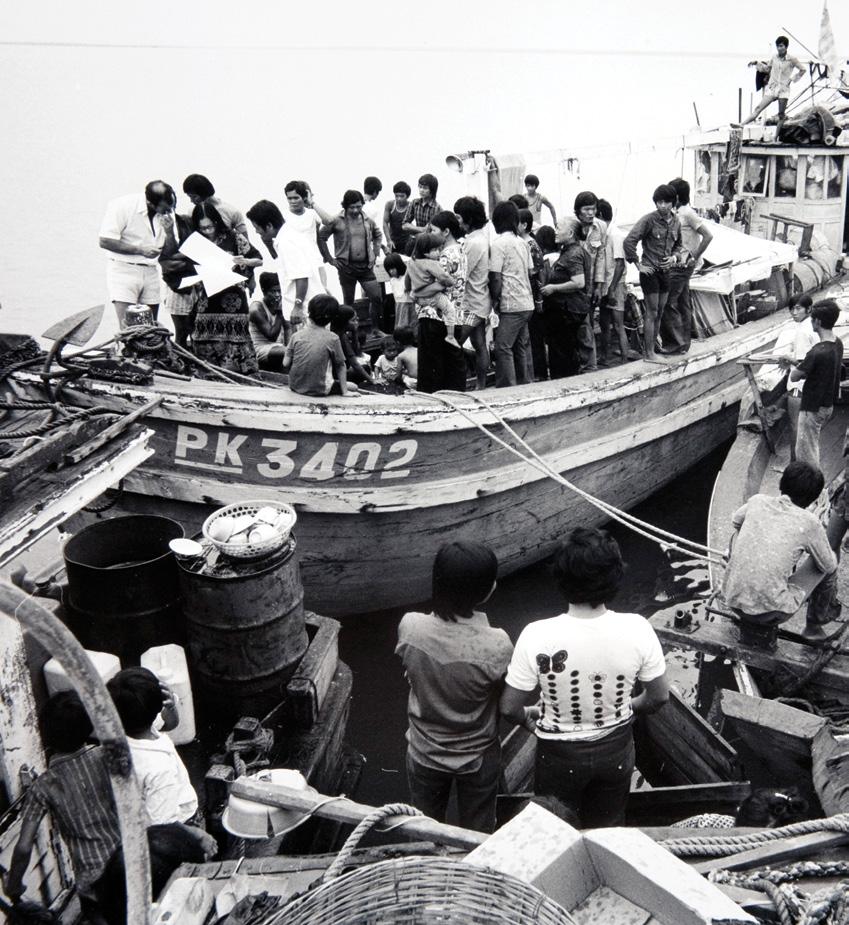 Photographer Michael Jensen took this and other stunning images of the boats arriving on 21 November 1977 in Darwin.
Left is PK 3402 with its 47 passengers, right is Tu’ Do with 31. Image © Michael Jensen
Photographer Michael Jensen took this and other stunning images of the boats arriving on 21 November 1977 in Darwin.
Left is PK 3402 with its 47 passengers, right is Tu’ Do with 31. Image © Michael Jensen

The many lives of refugee vessel Tu . ’ Do
On 21 November 1977, six refugee vessels entered Darwin Harbour with 218 people on board. One of them is now a central artefact of the Australian National Maritime Museum: Tu . ’ Do (Freedom). For the 45th anniversary of Tu . ’ Do ’s arrival, Curator of Post-war Immigration Dr Roland Leikauf uses new research to trace its history, from its construction in Vietnam to its exciting present in the museum.
A boat in the parking lot
ANYONE TAKING A RIGHT TURN on Murray Street in Sydney’s suburb of Pyrmont will be stopped by a large, sleek shape clothed in plastic. Behind the Australian National Maritime Museum rests one of its most important artefacts: the refugee vessel Tu’ Do. Conservators in personal protective equipment are hard at work, making repairs and preserving it for future generations.
The vessel was given its bright blue hull on Phú Quo � ´ c, a small island close to Vietnam and Cambodia. However, the person who had the boat built in July 1975 would have been very surprised that it still survives in 2022. It had been constructed for one specific mission: helping a group of desperate people flee Vietnam by sea.
Tan Thanh Lu had commissioned the vessel because he had to act quickly. In the aftermath of the Second Indochina War (or Vietnam War), the new communist government of Vietnam was strengthening its grip on the country. Anyone like Mr Lu, who ran a successful business and had connections to the now-defunct South Vietnamese government, was in grave danger.
To avoid suspicion, Tu . ’ Do (‘Freedom’) was built as a typical Vietnamese dragnet fishing vessel. The 39 conspirators would have to make do with a space designed for a crew of 10. Their plan called for leaving Vietnam under the pretence of a standard fishing trip, but instead crossing the Gulf of Thailand to reach Malaysia. Here, the refugees could try to gain entry into another nation, such as the United States.
Even though many had lived in places close to the water – Phú Quo � ´ c , Rach Giá or Long Xuyên – travelling on a small boat like Tu’ Do was not easy for the voyagers. Only some had maritime experience, and the boat was not built to cross large distances on the open ocean. Their journey had to be slow, following the coast except when large crossings, such as through the Gulf of Thailand, were inevitable. It took 60 hours to cross the gulf, and another two days along the Malaysian coast to Mersing.
Tu’ Do was well built, well provisioned and had a new, oversized engine. Many other people had to flee Vietnam under significantly worse circumstances. Some had no time to prepare for the journey; others could only procure unsafe boats. Engines broke down, provisions ran out; danger and catastrophe were part of the refugee experience. It is impossible to know how many vessels and passengers were lost on the way. Being discovered could mean helpful fishermen one moment and ruthless pirates the next. Survivors tell stories of theft, torture, rape and murder, but also of selfless help.
The colloquially named ‘boat people’ were part of one of the last events of massed migration to Australia by sea
Tu’ Do ’s voyagers were able to outrun the pirates and outsmart most patrols, and they arrived in Malaysia safely. They were not able to secure visas for the USA, however. Most decided to dare a second, much longer journey: passing Jakarta in Indonesia and the Lesser Sunda Islands to reach the coast of Australia. This time, they would cross not hundreds, but thousands of kilometres.
What was life on board like? The passengers often had to pretend to be fishing for hours to fool patrol boats. They could never be sure if the officials would be helpful or hostile – only that they would insist on sending them on their way. As a new boat with a well-prepared crew, Tu’ Do braved all the challenges the sea and other humans posed along the way. When authorities discovered the vessel close to the coast of Australia, the patrol boat HMAS Aware was sent to escort it into Darwin.1
Refugee vessels that were discovered from the air or were known to have left harbours close to Australia were often escorted by patrol boats. The Attack class patrol boat was one type of coastal defence vessel on active duty in the Royal Australian Navy. One of these vessels, HMAS Advance, is now part of the fleet of the Australian National Maritime Museum.
While there is some contradictory information about Tu’ Do ’s course, this is the most likely path the vessel could have taken, based on oral histories and official documents. Crossing the Timor Sea was the last challenge before the voyagers saw the Australian coast near Port Keats, after a journey of more than 5,000 kilometres.
Being discovered could mean helpful fishermen one moment and ruthless pirates the nextVietnam Phú Quốc Malay Peninsula Australia Darwin Port Keats Mersing Cambodia Borneo Sumatra Jakarta Java Sulawesi Lesser Sunda Islands Reok Timor Timor Sea Gulf of Thailand
Reuniting the vessel with Tan Thanh Lu and his family was an emotional experience for the voyagers
01
The Lu family aboard Tu’ Do at the museum in 2002: mother Tuyet (second from right) and children (from left) Mo, Dzung, Dao and Quoc Lu. Image Andrew Frolows/ANMM
02 Tu’ Do after it had been purchased by the museum and repaired, but before the Lu family had been found to provide advice on its original fitout and colour scheme. Image ANMM
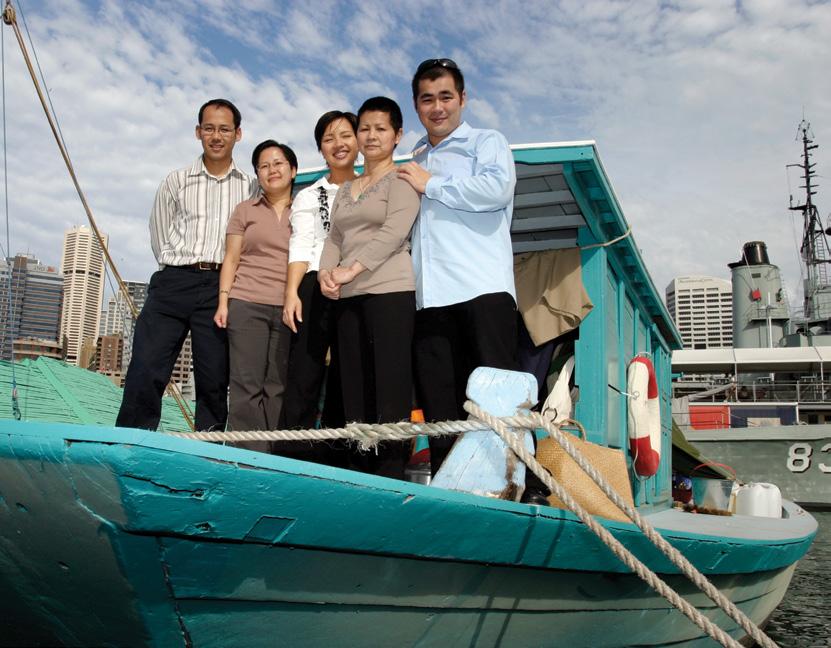

For the refugees, arrival in Australia meant the beginning of a new life. The voyagers spread all over the country and began to work, start families and forge futures. The vessels that brought them to Australia, however, were deemed to be illegally imported ships, and many were destroyed by the authorities or abandoned by their owners.
Mr Lu showed initiative and sold his craft early after arrival. Tu’ Do ’s second life, as a working vessel in the waters of the Northern Territory, began. It changed hands several times, was repainted and received a new name.
While many of the vessels of the ‘junk armadas’ supposedly threatening Australia during the 1970s and 80s were irrevocably lost, new institutions became interested in telling the stories of these refugees. 2
In the mid-1980s, the staff at the National Museum of Australia and the Australian National Maritime Museum decided to work together to acquire a refugee vessel even before their institutions had officially opened.
The first of these, Hong Hai, proved an excellent addition to the collection of the National Museum, but all efforts to make it seaworthy failed. When the Australian National Maritime Museum sent curators to the northern coast of Australia to look for an alternative, few of the vessels they inspected were still recognisable as Vietnamese. Only one, called We Believe, could not hide its origin as a Vietnamese fishing boat.
With the help of the current owner, the museum uncovered that this extraordinary vessel was the renamed Tu’ Do. When the museum decided to acquire it, Tu . ’ Do ’s third life began – again with a long journey. It sailed to Sydney on its own power and without incident.
The first mention was small: under the headline ‘Desperate voyages’, the museum noted in its magazine Signals in spring 1990 that it had acquired a ‘South Vietnamese fishing boat’. It also sent out a multilingual call for help: ‘Museum seeks Tu’ Do voyagers’. Through community engagement, contacts were established until all passengers had been either found or identified. Reuniting the vessel with Tan Thanh Lu and his family was an emotional experience for the voyagers, and their knowledge and stories proved invaluable for the museum.

01
Tan Thanh Lu, with his son Mo, at the helm of the restored Tu’ Do in 1995. Image Jeni Carter/ANMM
02
Wrapped and protected, Tu . ’ Do rests behind the main building of the Australian National Maritime Museum while undergoing extensive conservation and repair work. The space is accessible to the public and popular with visitors to the museum. ANMM Image

Removing a vessel from the water is like taking a fish from the sea; the sudden change can cause
devastating, irreversible damage
For years, Tu’ Do was part of many of the museum’s events and programs. People could see it in the water, go on board and discover its interior. However, a fishing boat of its kind is not meant to last forever. In 2021, Tu’ Do was removed from the water and it began another journey – but this time the destination was only a few hundred metres away.
Tu’ Do’s present and future
The vessel had become such an essential part of the museum’s offering to its visitors that a compromise was reached – repairs and conservation projects would be carried out in a space where the vessel was still accessible to the public.
The goal of these treatments is ambitious – to transform Tu’ Do from a vessel at home in the water to an artefact that prefers a completely different environment. Major parts of the process include adhering loose paint fragments, rinsing chlorides from the hull and reversing deterioration from environmental damage and attack by marine animals like shipworms (Teredo navalis). The real challenges, however, are the stabilisation treatments. Slow, controlled drying of the timbers using dehumidifiers, while constantly monitoring the wood, is vital. Removing a vessel from the water is like taking a fish from the sea; the sudden change can cause devastating, irreparable damage. Most visitors won’t notice any major difference once the process is completed, but this careful approach will protect the timbers of this unique vessel from shrinking, warping or even cracking – damage that would be irreversible.
Many of the vessels that were abandoned in the Northern Territory faced this fate. While crises like the MV Tampa affair or the sinking of SIEV (Suspected Irregular Entry Vessel) X in 2001 did keep the plight of refugees arriving by boat in the public consciousness, the colloquially named ‘boat people’ were part of the last events of massed migration to Australia by sea. If the curators hadn’t acted immediately, all their boats would have been lost forever.
Conserving an artefact like Tu’ Do is an important part of the Australian National Maritime Museum’s mission, but it also empowers refugees and their families and communities to reflect on and tell their stories in a public space. Like the Lu family and their fellow voyagers, many refugees have become integral to the Australian community. Once the conservation process ends, Tu . ’ Do will begin a new journey, most likely into the museum building. It will be essential then to ensure that it still can provide a space where those who came to Australia to stay and to belong can interact with the vessel and reflect about their past and their dreams for the future.
1 Tu’ Do and other boats trying to reach Darwin were often several hundred miles off course. Tu . ’ Do reached the coast of Australia on 20 November 1977 and the port of Darwin the next day.
2 Papua New Guinea Post-Courier, ‘Junk Armada on Way to Australia’, 28 July 1977, page 6.
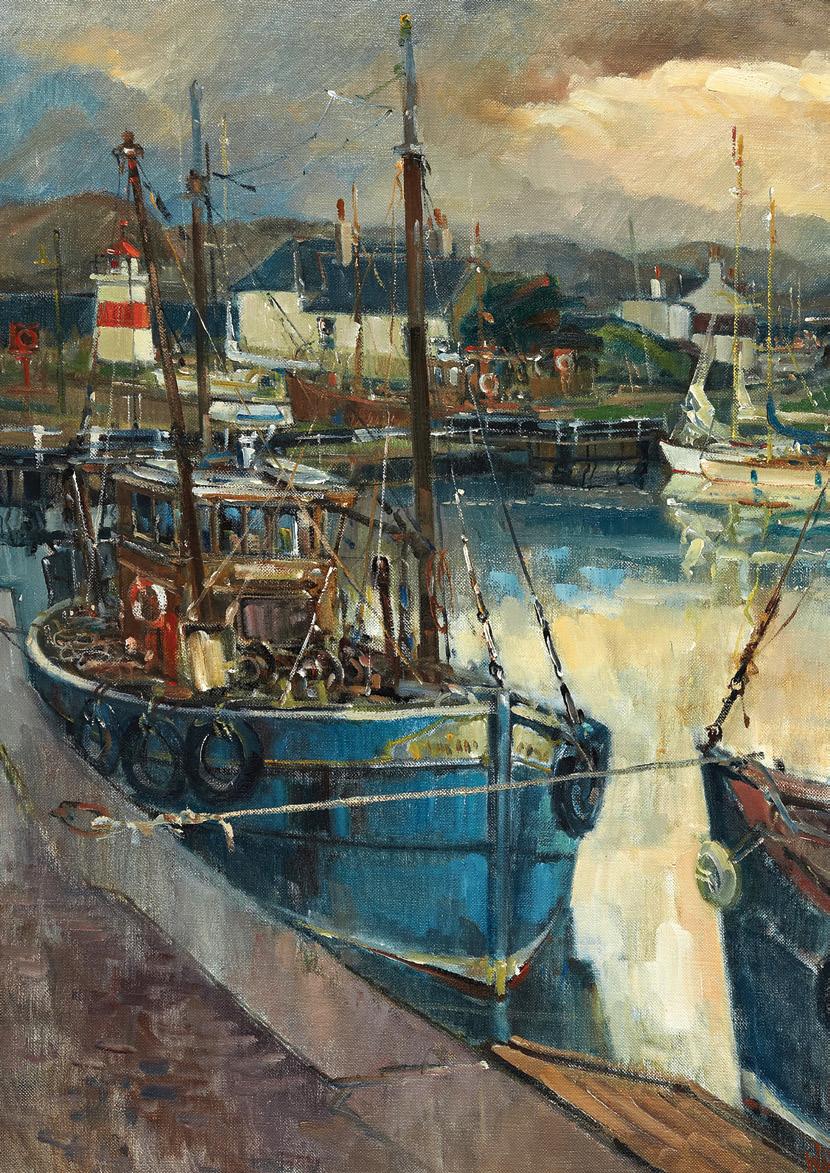
James Watt’s death at the age of 90 leaves the maritime world bereft of a great artist, but blessed by his unique legacy. As Scotland’s pre-eminent marine artist of the 20th century, Watt’s tireless work in capturing the industrial heritage of the Clyde is an unparalleled record of the era in which Scottish craftsmen built the most beautiful ships in the world. Bruce Stannard AM had the privilege of a poignant, personal meeting with Watt at the artist’s home on the banks of the Clyde.
THE CRYSTAL-CLEAR WATERS of the Firth of Clyde lap the shelly beach at the foot of James Watt’s garden at Largs in Ayrshire. Stretching away to the west, the isles of Great Cumbrae, Bute and Arran lie like battleships in line astern, their distinctive shapes bathed in subtle, successive shades of blue and grey. Curlews, eider ducks and goldeneyes dabble in the shallows, and far out in the depths of the Largs Channel, where fussing tugs manoeuvre giant coal ships towards Hunterston, there are whales, dolphins and porpoises at play. The Clyde is a different place these days; so peaceful, so placid, so utterly unlike the hammering cacophony
The Clyde, then the greatest industrial conurbation in Britain, was home to an army of craftsmen justifiably proud of their trade skills
of the artist’s childhood in the smoking shipyards of Port Glasgow over three quarters of a century ago. The change reminds us how quickly the apparent certainties of this world can be turned upside down, and how extraordinary it is that, in less than the span of one man’s life, an entire industry and the hundreds of thousands of people associated with it have been swept so completely away. How incredible that throughout it all, only one artist of any stature was on hand to capture the greatest sea-change in Scotland’s industrial history. How fortunate that artist was James Watt.
James Watt’s wonderful oils are alive with vibrant colour, vitality and the bold, confident brushstrokes of an artist who knew his subject intimately. Year after year he took his paints, brushes and canvases down to the teeming river and there, in all weathers, he captured the clanging, humming essence of Clydeside: the famous shipyards bristling with cranes, the handsome profiles of great ocean-going vessels, humble rust-encrusted puffers and salt-caked dredgers, barges, lighters, skiffs and tugs, all depicted under the threatening glare of ferocious skies. Today, Watt’s paintings hang in many of Britain’s most important collections. The British royal family has three. Early in our conversation, Watt made the point that before anyone can truly appreciate his work, they must first understand something of his own life and the experiences that informed, enhanced and shaped each one of his canvases. It is an extraordinary story.
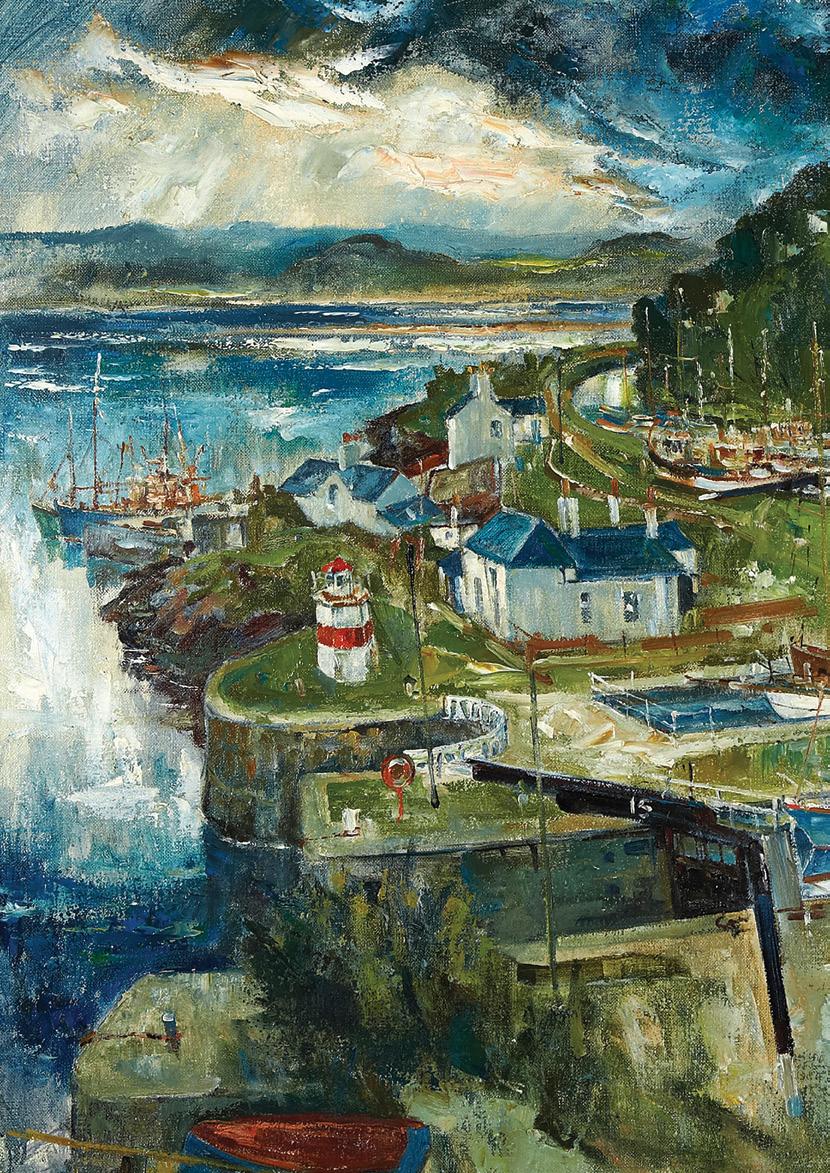
Crinan Basin, 1985, 91 x 122 cm.
For over 20 years one of James Watt’s favourite painting areas was along the Crinan Canal.
From the eastern sea entrance at Ardrishaig to Crinan Basin and the sea lochs with their stunning views to the west, he found inspiration every step of the way.
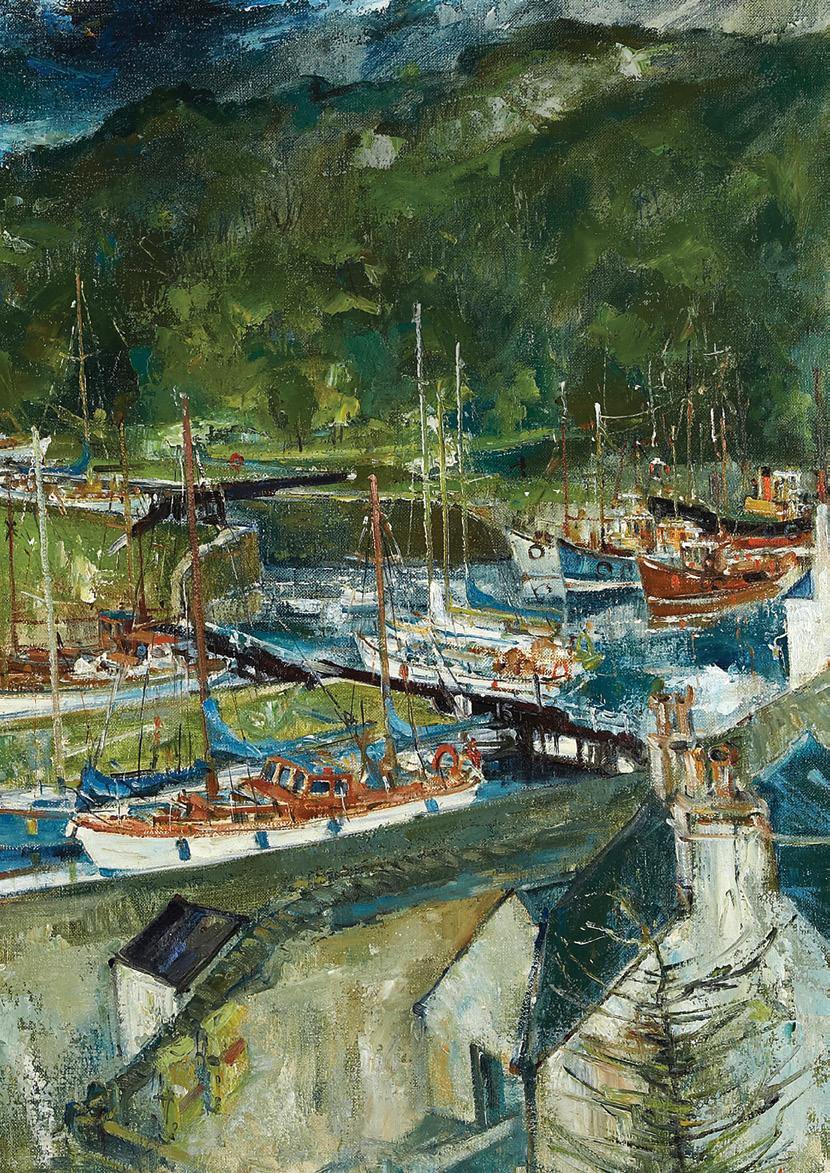
James Watt’s wonderful oils are alive with vibrant colour, vitality and the bold, confident brushstrokes of an artist who knew his subject intimately
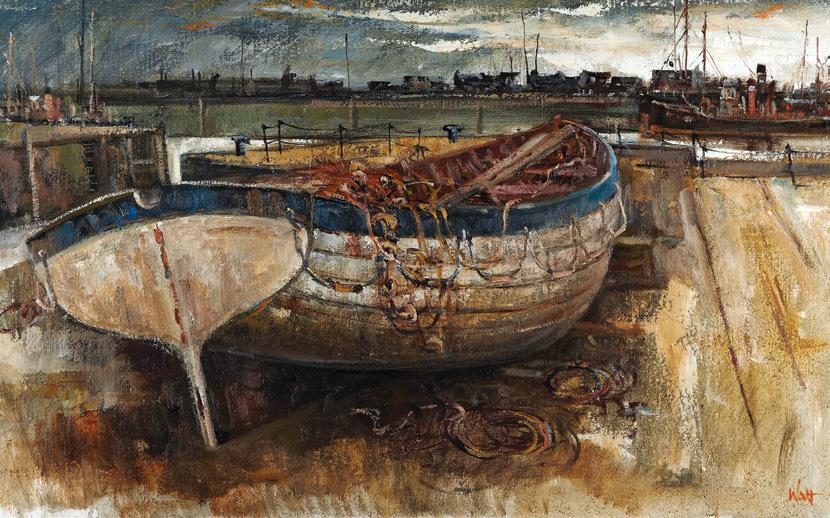
James Watt was born in the gloomy depths of the Great Depression. He was one of five brothers whose father, grandfather and uncles were all riveters, eking out a meagre hand-to-mouth existence on the lowermost rungs of the shipbuilding ladder. Life for James and his brothers therefore held no greater prospect than continuing in the unrelenting hard, dirty and dangerous work of the shipyards that sprawled before them at Port Glasgow. There, in a tiny two-room tenement, one of hundreds stacked cheek-by-jowl on the steep brae above the river, they looked out over the bristling cranes and the masts of ships. The Clyde, then the greatest industrial conurbation in Britain, was home to an army of craftsmen justifiably proud of their trade skills. The term ‘Clydebuilt’ was, in those days, not only a guarantee of superb engineering, it was a badge of honour, but one which also masked a grim reality. Watt told me:
The men who built those wonderful ships were among the finest craftsmen the world has ever known, and yet they spent their lives in abject poverty. Wages on the Clyde were terrible. Working conditions were awful. Many a family, my own included, scraped their way through life, living from one week to the next. This was typical of shipbuilders on the Clyde. It was a way of life that was based on the impoverishment of its workforce. For generation after generation we were locked into that cycle of poverty and there was just no way out financially.
Riveting was one of the most physically demanding of all the shipbuilding trades. Watt explained:
The riveters worked in four-man squads. Two men wielded heavy, long-headed hammers, one right-handed and the other left-handed, while another, known as a holder-on, had to dolly the rivet-head. The squad also included a boy whose job was to heat the rivets whitehot. The hammermen worked at such a tremendous speed that their blows sounded like machine guns. Speed was vital. The base of the rivet had to be hammered flat so that when it cooled its contraction drew the steel plates together so tightly that they formed a waterproof seal. In those days ships were built frameby-frame and plate-by-plate and hundreds of thousands of rivets were used to hold them all together. The ships were all built out in the open and the men were expected to continue working in all weather, summer and winter. It was a ferocious workplace in winter. Men worked down by the riverside with a bitter northerly wind coming over the snow-covered high ground. They were always very badly clothed. There was no concept of health and safety in the shipyards and for the most part the men were very ill-clad for the job. It was all cloth caps and old tweed suits.
The term ‘Clydebuilt’ was, in those days, not only a guarantee of superb engineering, it was a badge of honour

‘The men who built those wonderful ships were among the finest craftsmen the world has ever known, and yet they spent their lives in abject poverty’
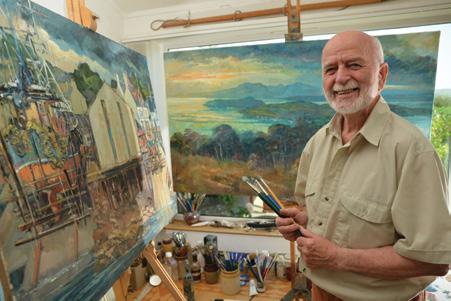
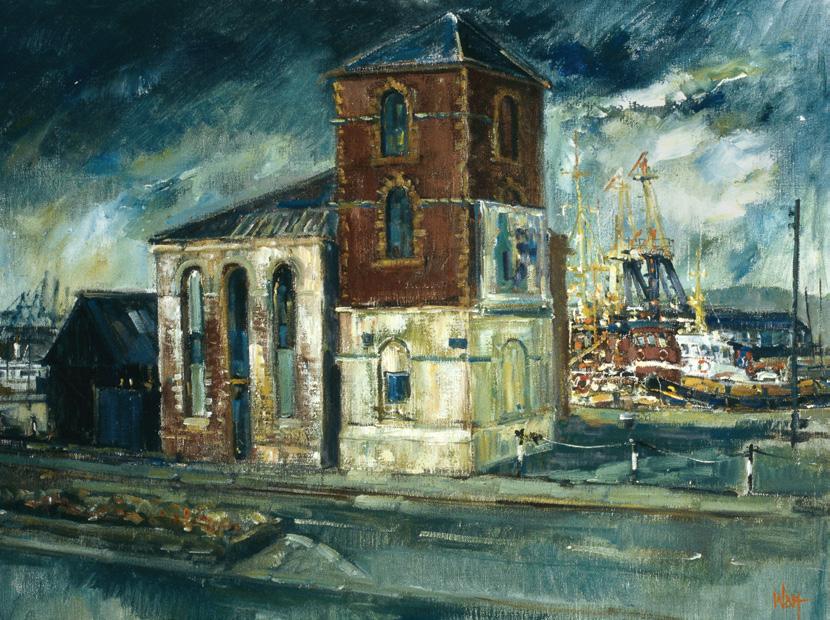
02
‘It was a ferocious workplace in winter. Men worked down by the riverside with a bitter northerly wind coming over the snow-covered high ground’
It was work that bred a very hardy race of men. James Watt remembered them as ‘small and tough and wiry.’ Most were around five feet six inches (168 centimetres) tall and although many were much shorter, they had the upper bodies of very big, powerful men. ‘Sons were expected to follow their fathers into the shipyards,’ he said:
Boys of 14 would leave school on a Friday and start work with their fathers on a Monday. If you started a trade you would stay in it all your life. It was common to have three generations of the same family all working together.
Although the shipyard workers’ houses were tiny, the families in them were large. Families with six children were common; some even had 10. They lived in houses that had one or two rooms and a single cold-water tap. An outside toilet was generally shared with up to three other families. Watt recalled:
In those days married women did not work. Once married, women were expected to give up their jobs in the rope and canvas factories and concentrate instead on what were known as ‘domestic duties’, that is to say, looking after their men-folk and their families. My mother did everything in the home. I don’t think my father made even so much as a cup of tea. One of the things I look back on with regret is that in spite of the fact that there were five sons in the house, not one of us ever lifted a finger to help our mother. It was grossly unfair, but my mother did the lot: washing, cooking, ironing, cleaning. She even brushed our boots. Yes, that was women’s work.
We had a two-room house in which my mother looked after my father, myself and my four brothers. One of the rooms was a kitchen with the cold-water tap and an open coal-fired range for cooking and heating. That room also had two beds in it, one for my parents and the other for the youngest son. The other room, which we simply referred to as ‘The Room’, contained a double bed and that’s where the other boys slept head-to-toe like kippers in a box. There was no electricity, only gas lighting. Our living conditions were pretty horrendous and yet, at the time, we weren’t conscious of our poverty. There were people all around us who were in exactly the same boat so, in a sense, we didn’t know any better. That was our lot. People accepted it. There was a great sense of community, a sense of shared deprivation I suppose. In times of trouble people helped each other and backed each other. Port Glasgow was incredibly congested, but it meant that within a hundred yards radius of our house I had two sets of grandparents, three or four uncles and dozens of cousins. They were proud people. They knew who they were. They knew what they were. They were Clydeside shipbuilders and they had no doubts whatsoever as to their own worth. They had what Scots refer to as ‘a good conceit of themselves.’ They thought, ‘We’re Clydesiders. We’re the best in the world.’ In drink their favourite toast was: ‘Here’s tae us, wha’s like us, damned few, an’ they’re deid.’
James Watt, born 17 November 1931, died 7 July 2022.
The author wishes to thank Alison Watt for permission to reproduce her father’s paintings.
Bruce Stannard AM is a renowned maritime author and a Life Member of the Australian National Maritime Museum.
01 James Watt in his studio at Largs, Scotland, 2013. Image Angus Blackburn/ Shutterstock Pumphouse, Victoria Harbour, 71 x 91 cm
The last of the big-gun warships
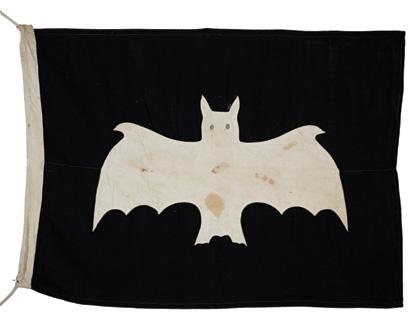
01
HMAS Vampire at sea.
Australian National Maritime Museum 00028535 Gift of Royal Australian Navy
Signal flag from HMAS Vampire, made on board in about 1970. It features the ship’s logo, a vampire bat with open wings. Australian National Maritime Museum 00037591 Gift of Norman Cooke
IN JANUARY 2023, one of the museum’s most treasured vessels will undergo a major refurbishment. We are inviting our members and supporters to contribute to this project, to ensure that HMAS Vampire remains on public display.
This Royal Australian Navy destroyer was built to a modified British Daring Class design at Sydney’s Cockatoo Island Dockyard and was launched in 1956. The last of the major gunships to be built, it originally had six 4.5-inch dual-purpose guns in three twin mountings; two single and two twin 40/60 mm Bofors AA guns; a Mark 10 Limbo anti-submarine mortar; and a quintuple 21-inch torpedo launcher. The standard ship’s company comprised 20 officers and 300 sailors.
HMAS Vampire served from 1959 until 1986 and, despite its firepower, had a peaceful career. In the 1960s, the ship escorted troops to Vietnam and in 1977 it was the RAN escort for HMY Britannia during the Queen’s Silver Jubilee tour of Australia. In 1980, it was refitted as a training ship. After its decommissioning, the ship was one of the first to be opened for display at the Australian National Maritime Museum for our 1991 launch.
In January 2023, as part of the ship’s five-year docking cycle, it will be towed to the Captain Cook Graving Dock on Garden Island. Vampire will undergo a four-week preservation program that involves ultrasonic fitness testing below the waterline to map rust and deteriorating plates. After doubler plating to reinforce the hull where needed, the vessel will be cleaned and repainted to enable its continued life as a world-renowned museum exhibit. Meanwhile, the curatorial and fleet teams are developing fresh plans to enhance our visitors’ onboard experience.
We invite you to give to this conservation program for our end-of-calendar-year fundraising campaign. You have the option to donate:
• online at sea.museum/donate
• by direct deposit: BSB 062 000; account number 16169309; reference: your name
• or phone 02 9298 3777 and speak to Matt Lee.
All donations are tax deductible.
To mark the occasion of the ship’s docking, we are planning a series of special events, including a sail on HMAS Vampire as it is towed to Garden Island on Tuesday 17 January 2023. Numbers are limited to 25 and we will contact you early in the new year about this rare opportunity.
The museum thanks you for your support.
A magical ghost ship leads you on a voyage of discovery beneath the waves as you interact with the wonders of our oceans. 1-hour playscape and performance.

On for a limited season 28 Dec – 26 Jan Tickets at sea.museum/shipwreck-odyssey
 Developed by the Australian National Maritime Museum and The Box of Birds / Stalker Theatre Team. Supported by EPIC Games Megagrants, Australia Council for the Arts, Create NSW and the Sydney Festival.
Developed by the Australian National Maritime Museum and The Box of Birds / Stalker Theatre Team. Supported by EPIC Games Megagrants, Australia Council for the Arts, Create NSW and the Sydney Festival.
I CAN’T BELIEVE it’s the end of the year already. This year seems to have just flown by. It was wonderful to see many of you at members events throughout the year, and we are currently putting together a great varied program for 2023.
We recently re-opened the Members Lounge and will be continuing to add to the space over the summer. And remember, the members spot at Ripples is still open for a free tea or coffee.
We recently sent out a members survey to get your thoughts about the museum and how we can make your membership better. If you haven’t already sent it back, then please reply by either email or post to help us improve the program. If you haven’t received the survey, then please contact the Membership office.
On behalf of the museum, I wish you all a happy holiday season, Merry Christmas and all the very best for 2023. I hope to see you at the museum again soon.
Matt Lee, Manager – VIP Relations & Members
01
Illustration by Gustave Doré for Coleridge’s The Rime of the Ancient Mariner. Intense lethargy is an early symptom of scurvy, a disease that will be discussed by Professor Richard de Grijs in his talk on 15 December. Image Wikimedia Commons
02
Embroidered map of the Western Hemisphere showing the tracks of the voyages of Captain James Cook, c 1800. Attributed to his wife, Elizabeth. ANMM Collection 00004991_002

Speakers Talk
Captain Cook and health at sea
2–3.30 pm Thursday 15 December
The Age of Sail witnessed amazing discoveries resulting from unequalled voyages of exploration. Yet shipboard conditions were often terrible and voyages dangerous, and many sailors perished. Captain James Cook was a true trailblazer in supporting his crews’ health. Join us for a rollercoaster ride, from the history of pickled cabbage as a source of vitamin C to daily dance sessions as early fitness routines. Presented by Professor Richard de Grijs.
Speakers Talk
Costa Concordia
2–3.30 pm Tuesday 31 January
Costa Concordia sank on 13 January 2012. The ship had 3,229 passengers and a crew of 1,023. After it hit a rock, all the vital compartments flooded, resulting in the loss of power and electricity. At this point everyone on the bridge knew the ship would sink. But captain Francesco Schettino wasn’t sticking around to find out.
Noel Phelan talks about the chain of events that led to this disaster and the brilliant engineering that managed to salvage the ship.
Speakers Talk
Voyages of James Cook
2–3.30 pm Thursday 23 February
This talk examines the life and times of arguably the world’s greatest explorer – James Cook. It covers his early life, his decision to join the Royal Navy and his rise to a position of importance. Andrew Phippen, from the museum’s Speakers Group, explores Cook’s three voyages of exploration and their profound influence in redrawing the map of the world
All talks are free for members and one guest. Bookings essential. To book members events, email memberevents@sea.museum and tell us which event you wish to attend, and who is coming. Alternatively, you can phone us on 02 9298 3777.
For all other events, please see sea.museum/whatson/events for further details and how to book.
For children’s and family programs, please check sea.museum or sea.museum/kids.
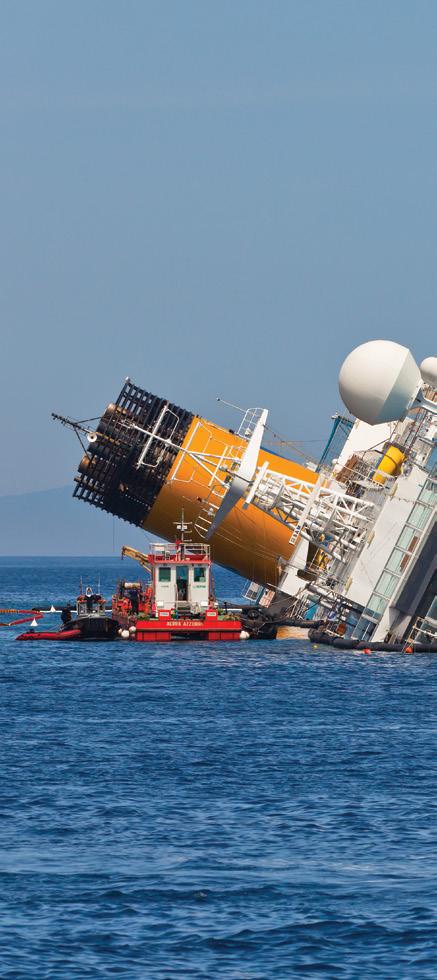
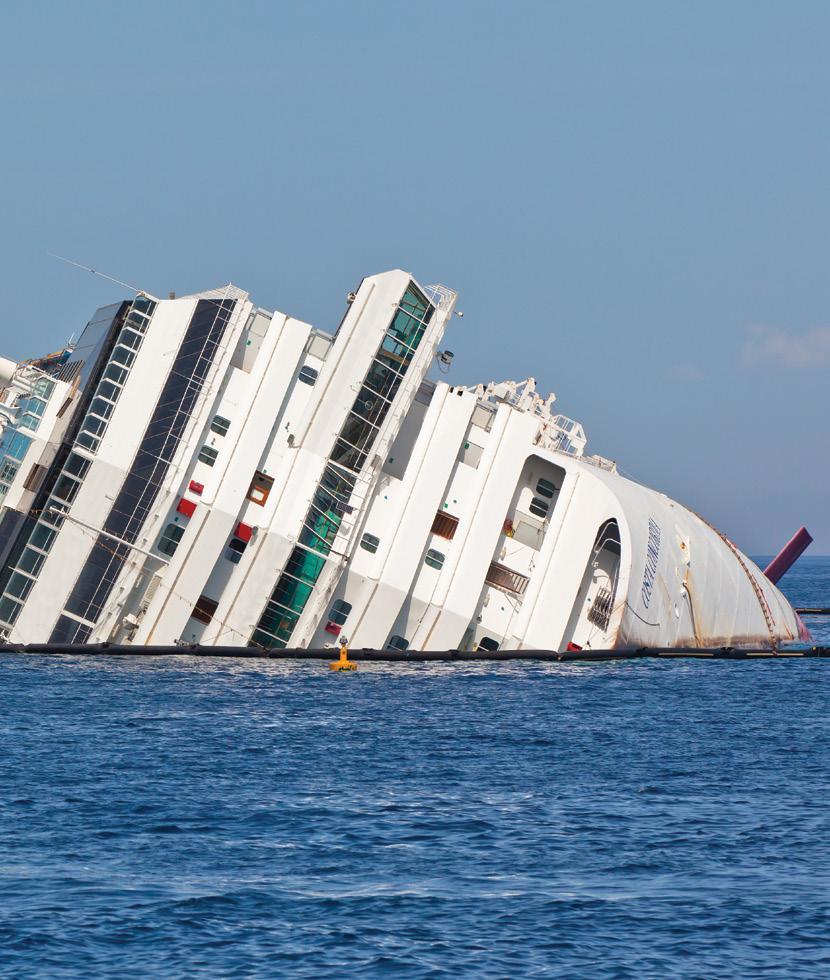
For the first time since it was donated in 1996, the entire Wharfies’ Mural is on display at the Australian National Maritime Museum, along with related artefacts.
THE MURAL was painted from 1953 to 1965 on the walls of the lunchroom at the former headquarters of the Waterside Workers’ Federation (WWF) on the ‘Hungry Mile’, now Barangaroo. The mural expresses the history and political philosophy of the WWF and other maritime unions from the 1890s to the end of World War II. Its subjects include the struggle for the eight-hour day, anti-conscription, the spread of Communism on the waterfront and the fight against Fascism.
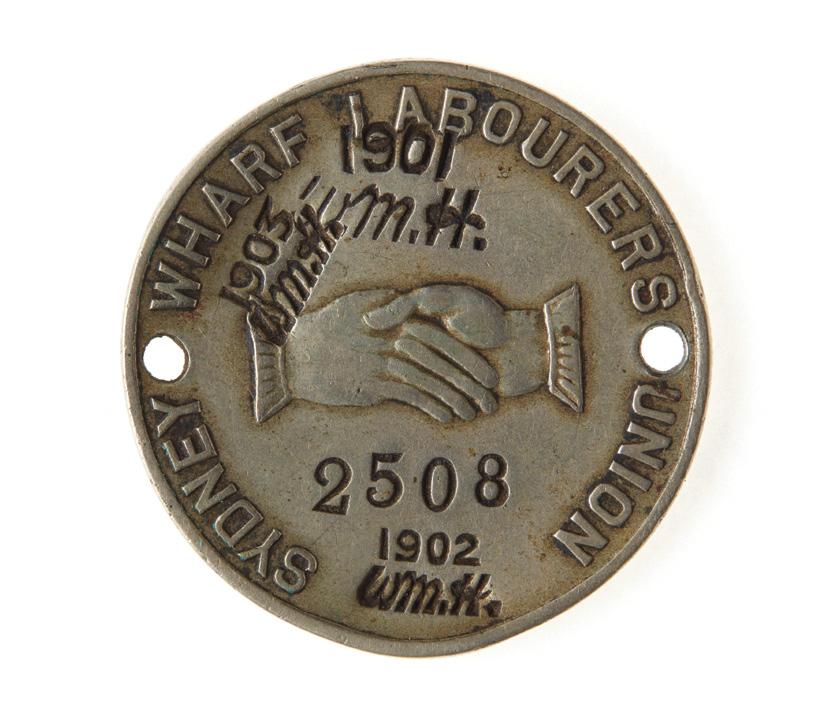
Sydney Wharf Labourers’ Union membership badge, No 2508 stamped with the initials of union secretary William Morris Hughes. ANMM Collection 00037817 Gift from Les Watson
On display in the Sydney Harbour Gallery are two splendid Chinese porcelain punchbowls painted with two different views of Sydney from the time of Governor Lachlan Macquarie (1810–21). One depicts the view from Dawes Point looking east, and was donated to the museum in 2006. The other shows the view from east Sydney Cove looking west, and was donated to the State Library of NSW in 1926. They were made in Canton as a pair in the early 1800s. The exhibit explores the mystery of who commissioned them and why, where they travelled thereafter and how they ended up in two different collections in Sydney.
Detail of the museum’s bowl. ANMM Collection 00039838 Gift from Peter Frelinghuysen through the American Friends of the Australian National Maritime Museum and partial purchase with USA Bicentennial Gift funds
From the Natural History Museum in London, this exhibition features more than 100 exceptional images that capture fascinating animal behaviour, spectacular species and the breathtaking diversity of the natural world.
Using photography’s unique emotive power to engage and inspire audiences, the images shine a light on stories and species around the world and encourage a future of advocating for the planet.
Wildlife Photographer of the Year is the most prestigious photography event of its kind, providing a global platform that showcases the natural world’s most astonishing and challenging sights. sea.museum/wildlife
A road slices through a tidal wetland. © Javier Lafuente/WPY57
Now showing
Deep Time – Shaped by the Sea tells the deep-past story of our relationship with the seas and inland waterways that make up our continent, revealed through the perspectives of modern science, maritime archaeology and Indigenous knowledge.
This new permanent exhibition transforms the way the museum interprets the National Maritime Collection and heralds a new chapter in our life and vision. The centrepiece of the exhibition is a commissioned work by the Mulka Art Project. This contemporary video installation called Dhaŋan Dhukarr (Many Pathways) brings together all the elements of the exhibition – land, water and sky – into an immersive cyclic reflection on deep-time Australia. sea.museum/shaped-by-the-sea
Brickwrecks – sunken ships in LEGO ® bricks
From 17 December
Featuring large-scale LEGO® models, real shipwreck objects, interactives and audiovisuals, Brickwrecks explores some of the world’s most famous shipwrecks, including Batavia, Titanic, Terror and Erebus
Developed and designed by the Western Australian Museum in partnership with the Australian National Maritime Museum and Ryan ‘The Brickman’ McNaught. sea.museum/brickwrecks
This small display brings together artefacts associated with Lieutenant James Cook’s famous HM Bark Endeavour In June 1770, 48 tonnes of material, including six iron cannons, were jettisoned from Endeavour in a successful attempt to save the ship after it ran aground on the Great Barrier Reef.
The Endeavour cannon is on loan to the museum courtesy of NSW Parks & Wildlife Service.


Ocean Wonders
Now showing
Over the past two years, Schmidt Ocean Institute has collaborated with research institutions from across Australia and the globe. Their mission: to explore the deepest and most remote parts of selected Australian and Pacific marine environments. This free outdoor exhibition reveals a selection of their stunning underwater images.
The exhibition can be viewed at the museum’s Wharf 7 forecourt.
Ocean Wonders is delivered in partnership with Schmidt Ocean Institute.
sea.museum/oceanwonders
Travelling exhibitions
Sea Monsters – Prehistoric ocean predators
Newcastle Regional Museum, NSW
Until 26 February 2023
Earth’s oceans were home to some of the largest, fiercest and most successful predators ever! While dinosaurs ruled the land, giant reptiles and sharks hunted the depths. What can their fossilised bones tell us about how they lived? How do they compare to today’s top ocean predators? Discover the secrets of these monsters of the deep in this exhibition for all ages.
sea.museum/sea-monsters-travelling
James Cameron – Challenging the Deep
North Carolina Museum of Natural History, USA
Until 7 May 2023
In an exhibition that integrates the power of the artefact and the thrill of experience, visitors will encounter the deep-ocean discoveries, technical innovations and scientific and creative achievements of underwater explorer James Cameron.
Created by the Australian National Maritime Museum’s USA Programs and supported by the USA Bicentennial Gift Fund. Produced in association with Avatar Alliance Foundation and toured internationally by Flying Fish. flyingfishexhibits.com/exhibitions/ cameron
Mariw Minaral (Spiritual Patterns)
Closing soon
An exhibition of the artwork of Alick Tipoti, a renowned Zenadth Kes (Torres Strait Islands) artist.
With over 25 years as an artist, Tipoti is respected for his work in regenerating cultural knowledge and language. Guided by the traditional cultural practices of his people, Tipoti’s storytelling encompasses traditional cosmology, marine environments and ocean conservation – focusing on what it means to be a ‘sea person’.
sea.museum/mariw-minaral
Remarkable – stories of Australians and their boats City of Busselton, WA Until 12 January 2023
Lawrence Rural and River Museum, NSW Until 29 January 2023
Wingham Museum, NSW Until 29 January 2023
Gladstone Library, QLD Until 29 January 2023
Bass Strait Maritime Centre, TAS Until 29 January 2023
Yarra Plenty Regional Library, VIC Until 29 January 2023
With over 1,000 rivers and a coast that stretches more than 36,000 kilometres, it’s no surprise that Australia’s history abounds with stories of people who have lived and worked on the water. This banner exhibition presents 12 stories from across Australia that explore the remarkable connections between people and their boats. Remarkable has been produced by the Australian Maritime Museums Council, its members and the Australian National Maritime Museum. This project was assisted by the Australian Government’s Visions of Australia program.
sea.museum/remarkable

The museum recently began hosting specialised programs for people with dementia. This came about in response to a query, which fortuitously coincided with the commencement of a new role at the museum, the Lifelong Learning Officer. The position is held by Anna Gregory, who explains how the program was developed.
During this research and training phase, I learnt about the challenges of social isolation and the feelings of disorientation that can be experienced by people with dementia. It was moving and inspiring to learn about the many strengths of people with dementia. All this research and training informed the overall aim of the program:
to develop and deliver affordable onsite programs for seniors, people with dementia and their carers, which promote reminiscence and story sharing, and encourage social interaction and connection.
IN JUNE, THE MUSEUM RECEIVED A QUERY from St Luke’s Care in the Sydney suburb of Potts Point asking whether we ran programs or tours for people with dementia. Over the next four months, as the new Lifelong Learning Officer, I immersed myself in research and resources relating to dementia. I investigated similar programs at other museums around the world and met with academics in the field of museums and aged care. I contacted Dementia Australia, Dementia Training Australia, Queensland State Archives and the Museum of Brisbane, and along with the museum’s other education staff, I completed online training courses.
Once the purpose of the program was clear, education staff began preparing the program plans.
As well as housing the National Maritime Collection of artworks and heritage objects, the museum also has an Education Collection, comprising objects that visitors can touch and handle. For the program for people with dementia, we selected Education Collection objects that we hoped would spark happy recollections and encourage discussion among participants. Together, we developed two themes: ‘Swimming and the Beach’ and ‘Suitcases and Travel’.
One visitor recalled sending a postcard from Sicily that took ten years to arrive in Clovelly! 01
A colourful array of photos, cruise ship menus, postcards and souvenirs from the museum’s Education Collection. 02 Graham and his daughter Deb shared memories of glamorous cruising holidays and travelling around regional Australia for work. All images ANMM
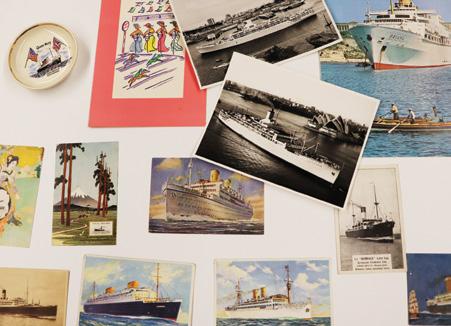
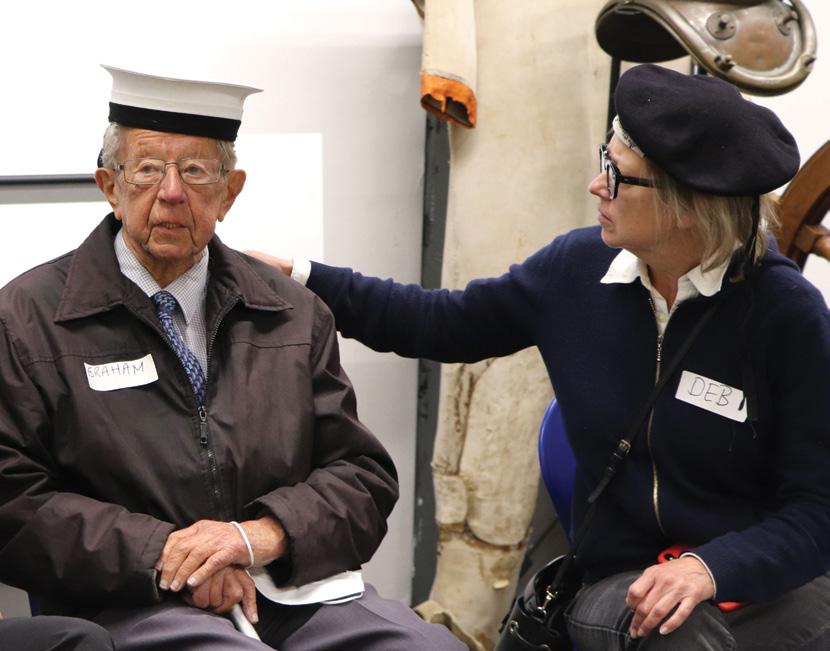
01
Reminiscence sessions are a wonderful opportunity for participants and carers to share stories in a safe, welcoming and respectful environment. 02
Themed programs include dress-ups. For the ‘Suitcases and travel’ program, Anne is wearing a replica Royal Australian Navy hat while reading a cruise ship menu from the Education Collection.
Staff encouraged participants to share their memories, experiences and stories, which were adventurous, amusing, uplifting and inspiring
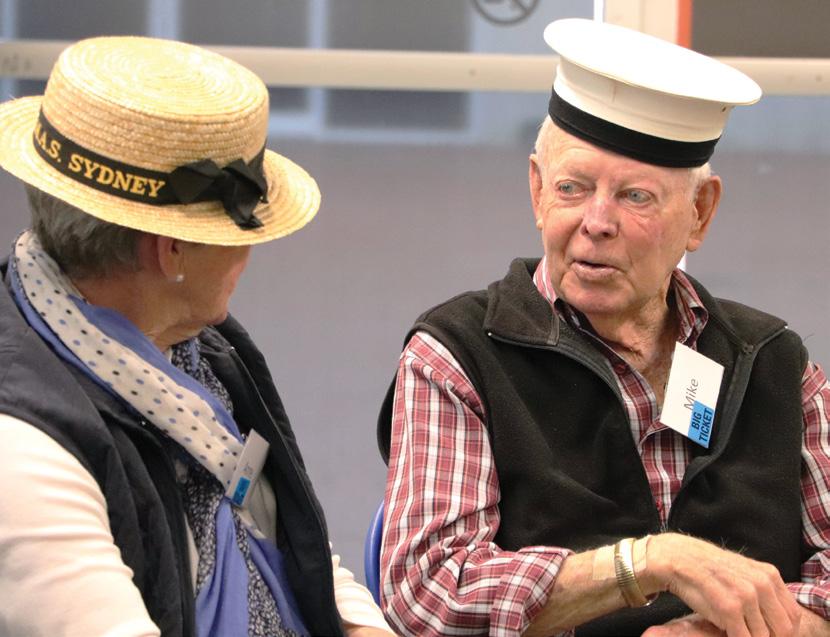

The new program for people with dementia, named Seaside Stories, was launched in September, and our first visitors were from St Luke’s Care. The programs began with themed reminiscence sessions. Participants were able to hold objects from the Education Collection, while Education staff encouraged participants to share their memories, experiences and stories, which were adventurous, amusing, uplifting and inspiring. One visitor recalled sending a postcard from Sicily that took ten years to arrive in Clovelly! Another shared memories of working as a surf life saver on Bondi Beach, and one woman recalled dressing up in a different frock every night of a two-week cruise. It was humbling to hear a visitor’s recollections of migrating from Germany to Australia as a nine-year-old girl. She expressed her immense gratitude to Australia for welcoming her and giving her a home. This handful of anecdotes reflects the innumerable achievements and contributions of these individuals. It was a privilege to hear these small snippets of their experiences.
Following the reminiscence sessions, the participants and their carers shared morning tea together at the museum’s cafe. It was heart-warming to see friendships developing and support networks strengthening over a cup of tea and cake.
Seaside Stories was launched during Dementia Action Week (19–25 September)
To round out the program, museum educators led the visitors from St Luke’s Care on tours through the museum. Tours were carefully planned to cater for the sensory preferences and mobility needs of the group. The education staff recounted the tragic tale of the Dunbar shipwreck, narrated the thrilling story of Kay Cottee’s circumnavigation of the globe, and explained the frightening reality of ghost nets in our oceans. During the tours, participants asked questions and explored the exhibitions independently and safely, with museum staff and carers available if needed. Museum staff also carried portable seating during the tours, in case visitors needed to rest.
Seaside Stories was launched during Dementia Action Week (19–25 September). This awareness-raising campaign seeks to eliminate discrimination, improve education around dementia and encourage Australians to support people living with dementia and their carers. It was important for the museum to launch Seaside Stories during this week to demonstrate our support for people living with dementia.
Participants and carers from St Luke’s Care responded very positively to our first delivery of Seaside Stories. In the post-program survey, one participant responded: ‘THANK YOU. It was very valuable. It sparked so many memories and stories’. The only criticism we received was that there ‘could have been more sessions. There was still so much to see!’
It was a privilege to design programs for people with dementia, and it was an honour to hear the stories of the participants and their carers. Seaside Stories joins a suite of other lifelong learning and accessibility programs offered by the museum, including Sensory Friendly Sundays (an inclusive program for neurodivergent visitors and their families).
For more information on Seaside Stories, or to book, please email anna.gregory@sea.museum .

Berryman’s sarong was bought in Brisbane and issued to him as part of his disguise for the mission
The sarong was bought in Brisbane and supplied to Moss Berryman as part of his commando kit for the mission.
Image Jasmine Poole/ANMM
The family of Able Seaman Mostyn ‘Moss’ Berryman recently offered the museum a unique and very generous donation: the cotton sarong he wore as part of his Malay fisherman disguise while serving aboard MV Krait during Operation Jaywick in 1943. Curator Dr James Hunter discusses the sarong and its significance to Australian maritime and naval history.
OPERATION JAYWICK IS UNIQUE among covert wartime operations in Australia as the only wholly successful mission of its type to be carried out during the Second World War. While all the mission’s operatives wore sarongs as part of their disguise, no other examples are known to have survived the war.
On the night of 26 September 1943, six members of Australia’s Z Special Unit carried out a daring clandestine raid against Imperial Japanese shipping in Singapore Harbour. To avoid detection, the men had been transported deep into enemy territory aboard a Japanese-built fishing vessel, assumed the appearance of local fishermen, and launched their attack using ‘folboats’ (folding kayaks) and limpet mines. The mission, Operation Jaywick, was a complete success, resulting in the damage or destruction of seven Japanese ships, with no Allied losses. The boat that served as Operation Jaywick’s ‘mothership’, MV Krait, survived the war, was returned to Australia in 1964 and has been on display at the museum since 1987.
Since then, the museum has acquired other objects associated with Operation Jaywick, including a fake Japanese ensign souvenired from Krait by its commander, Lt Hubert ‘Ted’ Carse, as well as Carse’s ‘knuckle knife’ issued by Special Operations Australia (see Signals 135, pp 66–69). The museum also holds two other items specifically associated with Moss Berryman. Now part of the National Maritime Collection, they are his Malayan parang , or machete, and its sheath, and a spring-loaded telescoping truncheon issued to him when he joined Z Special Unit. They are now joined by Berryman’s sarong, an object that is singularly evocative of the covert nature of Z Special Unit and the folboat assault on Singapore Harbour. It also has a powerful connection to Krait, given that the success of Operation Jaywick – and the vessel’s very survival – depended upon how effective the subterfuge employed by the operatives was in convincing not only the Japanese military, but also the inhabitants of the islands and waters through which they transited.
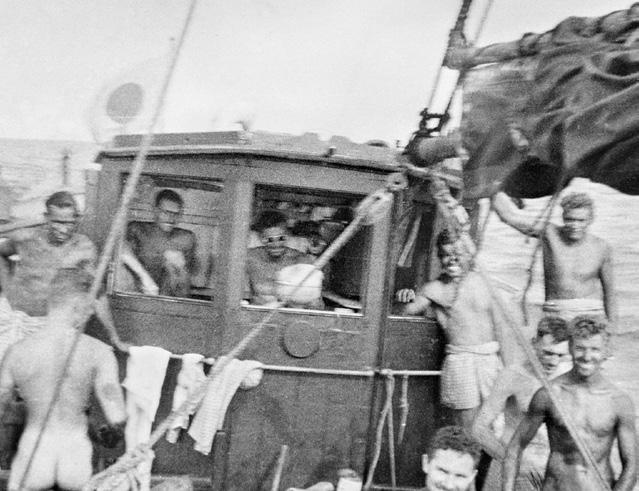
Moss Berryman was born in the Adelaide suburb of Kent Town, South Australia, on 9 November 1923. He enlisted in the Royal Australian Naval Reserve on 6 March 1942 and reported for duty as an Ordinary Seaman at HMAS Cerberus on 7 April. One year later, he was promoted to Able Seaman and assigned to HMAS Moreton, from where he was ‘appropriated’ to serve with the Services Reconnaissance Department, the official cover name given to Z Special Unit. Berryman served as a crewman aboard Krait and a reserve canoeist during Operation Jaywick but did not take part in the folboat attack on Singapore Harbour. Although not a member of the assault team, his role was nonetheless critical, as he was responsible for maintaining Krait ’s guise as a fishing boat and keeping the vessel in good working order, while also being prepared to engage in combat should the mission be compromised. Berryman was also tasked with safely delivering and extracting the six covert operatives, ensuring the mission’s success.
Because they were forced to hide in plain sight, the Operation Jaywick team adopted subterfuge to avoid detection – including using the fake Japanese ensign, wearing sarongs and covering their bodies in dark makeup to give the appearance of local fishermen. Berryman’s sarong was bought in Brisbane and issued to him as part of his disguise for the mission.
Perhaps surprisingly, it is both colourful and intricately decorated. It is manufactured from cotton cloth and printed on one side with a pattern of flowers, birds and butterflies in vivid purple, blue, green and orange. It appears to be an example of kain batik, a form of Malay sarong featuring batik motifs and designs that typically incorporate bright colours and imagery of plants and animals. Although normally associated with women’s attire, kain batik were also sometimes worn by Malayan men. The more common form of sarong worn by Malayan men was the kain pelikat, which features a simple stripe and box pattern.
Another of the sarong’s surprising attributes is its overall condition. Save for a few small stains, its fabric and decorative elements are very well preserved, with no notable tears or abrasions. This is remarkable, given it was probably worn for the duration of Operation Jaywick without regular washing. However, that all changed once the mission concluded. According to Berryman’s youngest daughter (and the sarong’s donor) Rosemary Hayward, her paternal grandmother was a ‘clean freak’ who likely washed and ironed the sarong ‘to within an inch of its life’ upon his return home. It was then packed away with other wartime souvenirs and forgotten.
01
Members of Operation Jaywick staining their bodies and donning their Malay fisherman disguises. Mostyn Berryman is lower left, with his back to the camera. Their fake Japanese ensign is flying in the background.
Australian War Memorial 067336
02
Members of Operation Jaywick aboard MV Krait, cleaning and checking weapons before their successful clandestine attack. Mostyn Berryman is at the front. Australian War Memorial P00986.002
02
Berryman was responsible for maintaining Krait ’s guise as a fishing boat and keeping the vessel in good working order


In the wake of Operation Jaywick’s success, Berryman was asked whether he wanted to return to Singapore as part of a larger, repeat operation. He carefully considered the proposal before declining. The mission, Operation Rimau, resulted in all operatives either being killed in action or executed by the Japanese. Berryman was mentioned in despatches in April 1944 ‘for gallantry, skill and devotion to duty in a hazardous enterprise’ and demobilised from service on 21 February 1946, when he was serving aboard HMAS Vendetta (I).
After the war, Berryman resumed his job as a clerk with the stockbrokers SC Ward & Co and remained there until retiring 46 years later. He married his childhood sweetheart Mary Cant and they had four daughters. Berryman was aboard Krait when the vessel entered Sydney Harbour in 1964 to become a museum ship and advised the museum’s former Curator of Historic Vessels, David Payne, on the vessel’s 2017 refit to its 1943 configuration.
Payne cultivated a friendship with Berryman over several years and was informed about the sarong’s rediscovery, which occurred when Berryman was going through his cupboards one day and found it along with other Operation Jaywick objects he had forgotten about. Berryman also confirmed to Payne that the sarong was the one he had worn on the raid and stated his intention to donate all Operation Jaywick objects in his possession to the museum. The lone exception was the sarong, which he gave to his daughter Rosemary.
Moss Berryman died on 6 August 2020 at the age of 96. He was the last surviving member of Operation Jaywick (see Signals 133, pp 72–73). Shortly afterwards, Rosemary Hayward kindly offered to donate his sarong to the museum.
Dr James Hunter is the museum’s Curator of Naval Heritage and Archaeology.
Berryman was aboard Krait when the vessel entered Sydney Harbour in 1964 to become a museum ship and advised on the vessel’s 2017 refit to its 1943 configuration
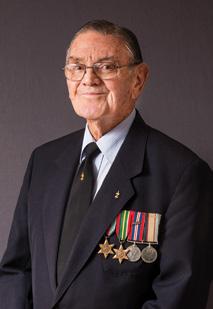
01
Krait on the Brisbane River, February 1943, from a souvenir postcard from the Z Special Unit Association. ANMM Collection
02
Studio portrait of PA2717 Able Seaman Mostyn Berryman. Australian War Memorial AWM2017.520.1.3973. Photographer Helen Roberts for the ‘Reflections – Honouring our WWII Veterans’ Project


In our lives, we have developed a deep affection for place. My wife and I believed our inscription on the National Monument to Migration would mark our appreciation of the opportunity to live in this exceptional country.
Richard J Arculus, speaking at the unveiling ceremony
MORE THAN 2,000 PEOPLE visited the museum on Sunday 23 October for a special ceremony in which 876 new names were unveiled on the National Monument to Migration. With these additions, the monument now features over 32,000 names from more than 138 countries.
The National Monument to Migration honours the thousands of migrants who have travelled across the world to call Australia home. Each year, more names are inscribed on the bronze-panelled wall that faces Darling Harbour and Pyrmont Bay – historically the site where many migrants first arrived.
Four speakers, whose names were among those newly added to the monument, shared their migration stories at the event – Nick Lewocki, of Polish heritage; Eugenia Mitrakas, from Greece; Richard J Arculus, of Indian heritage, whose wife came from Jordan; and Stephen Nguyen, whose parents travelled in extreme circumstances from Vietnam.
Margarita Tomaras pointing to her inscription. Image Marinco Kojdanovski
‘The experiences of the people whose names are inscribed on the monument celebrate our commonality’


The National Monument to Migration monument now features over 32,000 names from more than 138 countries
Museum Director, Daryl Karp am, said:
The story of migration to Australian shores is a foundational one in our maritime history. The National Monument to Migration honours the many people whose stories and contributions have shaped our nation.
The experiences of the people whose names are inscribed on the monument celebrate our commonality – love of family, community and striving for a better life. Some of their stories tell of loss and sadness, some of triumph – but, ultimately, all are about hope.
The National Monument to Migration features the names of migrants from all corners the globe and it is this diversity that gives it its strength. We also work with individuals and communities in special initiatives to honour waves of migration or communities of migrants.
One particular initiative is the Greek Bicentenary Fund, for which the museum has worked closely with the Greek community over the past year in a special fundraiser to commemorate the 200th anniversary of the Greek War of Independence and to honour the contribution of Greek Australians in building our nation. The support received for this fundraiser resulted in the names of 244 Greek and Cypriot migrants being added to the monument – among these, the first ten Greek migrants to Australia.
Donors are invited to contribute a brief story about the person being honoured and a brief biographical note to be published on the museum website. The museum is building an online archive of stories from these names; stories that, in turn, tell the tale of modern Australia.
We would like to thank the many organisations that have supported the Greek Bicentenary Fund, including the Greek Welfare Centre, The Greek Herald, Greek City Times, Greek Festival of Sydney, AHEPA Australia, AHEPA NSW, Lemnian Association of NSW and Sydney Restaurant Group.
The museum is now accepting names for the next panel on the monument, which is to be unveiled in May 2023. Registrations for this panel close on 22 December 2022.
To be included on the next panel, visit sea.museum/nationalmonument or call 02 8241 8337.
Kate O’Connell and Pamela Proestos
On 28 January 2023, we will again host the New Beginnings Festival, a free family-friendly event presented by Settlement Services International in association with the Australian National Maritime Museum. Hannah Gartrell provides a preview.
THE NEW BEGINNINGS FESTIVAL is returning to the Australian National Maritime Museum in 2023 as part of one of Australia’s largest cultural events, Sydney Festival. It will showcase culturally and linguistically diverse artists and promote social inclusion through artistic and cultural expression.
Joining forces to open the festival are acclaimed Lebanese singer, composer and songwriter Samira El Koussa and Assyrian singer and oud player George Karam (known in Arabic music circles as the ‘Assyrian King’). The pair will perform in an original band commissioned by Settlement Services International (SSI), along with six other outstanding musicians and performers.
Visitors will be able to sample food from around the world and browse an eclectic array of market stalls owned and run by refugee, migrant and First Nations entrepreneurs. While the festival offers Sydneysiders an enjoyable and uplifting day out, the event’s core focus is to support the artists and entrepreneurs involved.
Participation in the arts plays a critical role in helping people to forge their identities and build more inclusive communities for everyone. For refugees and new migrants to Australia, it is particularly important to connect with people from diverse backgrounds and experiences and to share the joy of creative expression.
Contributing to the fabric of Australian cultural life is essential in building a sense of belonging for many new arrivals. Platforms for connection and self-expression like the New Beginnings Festival empower individuals, bring communities together and help build a stronger society. This is the first time that New Beginnings has been included in the Sydney Festival, which will increase its impact and expose the artists and stall-holders to an even wider audience.
SSI is a national not-for-profit organisation that has held the New Beginnings Festival annually since 2015. The 2023 event will be the second time that the museum has hosted the festival as part of a three-year partnership between the two organisations. The partnership aligns with the purpose of the festival, which is to advance social cohesion and harmony in Australia within the context of migration.
Both SSI and the museum have pledged to provide a wide range of opportunities for newcomers to experience the arts, culture and history of their new homeland, form new connections and acquire knowledge, skills and confidence.
To learn more about the New Beginnings Festival, visit newbeginningsfestival.com.au
Hannah Gartrell is the Head of Executive Communications and Media at Settlement Services International.
The event’s core focus is to support and empower the artists and entrepreneurs involved
01
A member of Ile Ilu, a women’s percussion group, performs.
02 Artists with different backgrounds and experiences came together for the New Beginnings Festival in 2021. Images courtesy SSI.

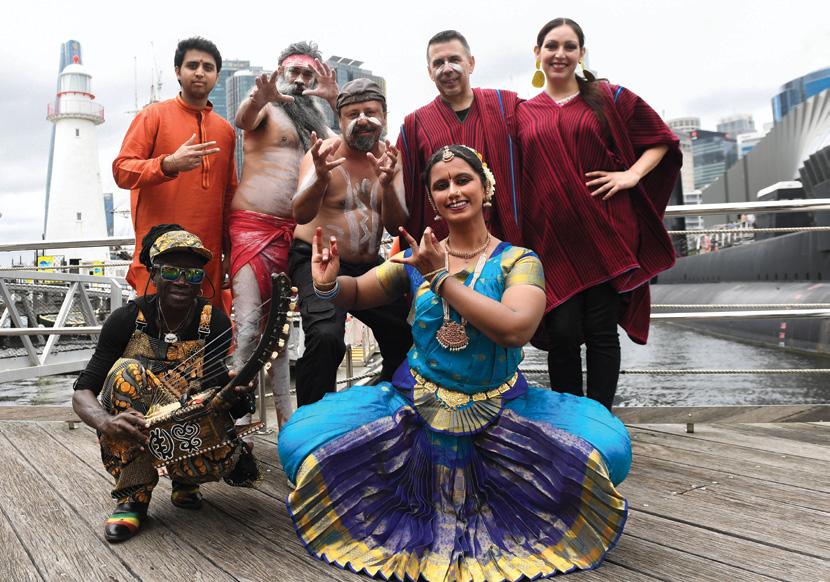

uses various artistic styles and works as inspiration for his art.
This white-on-black illustration is styled on The Last of England (opposite) but replaces English migrants with Afghan refugees.
Life in Villawood is not a respite from the plights that the refugees have experienced, but a continuation in different form
a

GRAPHIC NOVELS are still far from being accepted as mainstream publications, especially when they deal with complex topics such as immigration. So it was extraordinary that Still Alive, a graphic novel from Sydney-based artist, musician and educator Safdar Ahmed, won Book of the Year in the NSW Premier’s Literary Awards in 2022. The judges stated that it ‘demonstrates how comics can be a sophisticated medium for narrative, self-reflexivity and reportage’.1 Reporting was not the author’s aim when he began the project that would lead to the novel’s creation. He wanted to create art for, with and about the refugees waiting to be processed in the Villawood detention centre, 29 kilometres west of the Sydney CBD. Drawing could be a way for people to pass the time, and a tool to visualise emotions, hopes, traumas and frustrations – things that many cannot express in other ways. He soon realised that for people like him who are living in freedom, detention centres are a black box: completely isolated, with a predefined narrative and restricted means of communication, controlled by a strict hierarchy, and organised by private companies working for the government.
Some of the drawings were published in an awardwinning online comic project, Villawood: Notes from an immigration detention centre, but the graphic novel contextualises the works and weaves them into a greater narrative. It shows that life in Villawood is not a respite from the plights that the refugees have experienced, but a continuation in different form. The losses they have endured and traumas they have undergone add to the challenges of ongoing detention: the constant fear of deportation, the inability to help friends and loved ones, limited privacy and the threat of being detained for an undefined time.
The novel is effective and powerful because it tells its stories through the artworks of both the author and the refugees, weaving them together into a rich tapestry of experiences and expressions. The reader can see that the art was created when the artists were still trying to define what their co-operative project could mean and how it could work. The amalgamation of background information, stories from different timeframes and brutally direct art creates the special intensity of Still Alive
The tales are true refugee stories: complex, contradictory and chaotic. There is Haider, a refugee from Afghanistan who lost most of his family to the Taliban and who is able to go to the UK after being stranded in Iran. He builds a life and career, only to be deported to Afghanistan in 2011. Because he belonged to the Hazara minority, his life was in immediate danger. What saved him was the thoughtfulness of a friend back in the UK, who had sold his car for him in the meantime. This money bought him a passport and entry to Australia – and brought him to Villawood. Haider’s journey represents the cycle many refugees live in – wasting their lives while waiting and saving money, only to risk everything in one more failed escape attempt that returns them to square one. Haider’s example is especially compelling because it shows that refugees have agency and free will, but are at the same time helpless, fighting against powers beyond their control. Haider’s eventual release into the Australian community from Villawood shows the long-term effects of detention. He must both rebuild his life that was destroyed in Afghanistan, and fight against the calcification of his traumas and abilities during his time in Villawood.
Still Alive is the rare book that is both hard to put down and equally hard to continue reading. It depicts people fleeing from oppression and danger who are thrown into a system that is supposedly safe but has dire consequences for their ability to cope with their past and prepare for their future. Self-harm, depression and violence are a part of the detention experience, and while offshore locations on Manus or Christmas Island are more extreme, violent, run-down or dangerous than Villawood, the damages that are wrought are very similar. The author never tries to glorify the people he works with and writes about. Refugees are not elevated by their suffering to be better people than others –they are humans and have a right to be treated as such.

The novel is effective and powerful because it tells its stories through the artworks of both the author and the refugees
Still Alive: Notes from Australia’s immigration detention system
By Safdar Ahmed, published by Twelve Panels Press, Melbourne, 2021. Softcover, 240 pages, illustrated.
ISBN 9780980593730
RRP $30.00
Vaughan Evans Library
VEL 325.210994 AHM
The graphic novel is unapologetically political. It has to be. The author describes how legal and political frameworks and the actions of politicians and the news media directly affect the lives of the people in Villawood. While it also depicts life after detention, Still Alive is not a happy tale – it cannot be. Any kind of imprisonment crushes the spirit, and the novel shows in painful detail how isolation, indifference and prejudice permanently transform individuals for the worse.
The novel is also a reminder of the power art has to externalise and sometimes exorcise that which cannot be expressed or dealt with in other ways. Not overcoming, but acknowledging, trauma is the first step to living with it. This means that the novel often comes painfully close to being unreadable, because the suffering is overwhelmingly strong, both visually and narratively. Despite this, it is a book that deserves to be read.
Reviewer Dr Roland Leikauf is the museum’s Curator of Post-war Immigration.
1 State Library of New South Wales, judge’s comments, sl.nsw.gov.au/ awards/book-year/2022-winner-still-alive, visited 06/10/2022.
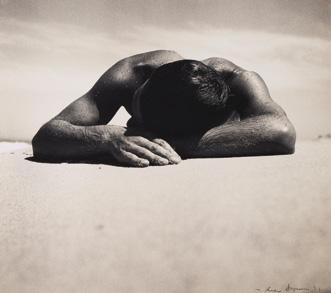
01
Max Dupain (Australia 1911–92), Sunbaker 1937, printed 1970s. Gelatin silver photograph, 37.9 x 42.8 cm. Art Gallery of New South Wales, purchased 1976. Image © Art Gallery of New South Wales 115.1976
02
One of the author’s artworks echoes Max Dupain’s iconic Sunbaker, but depicts an exhausted man lying on the deck of a boat during a long and arduous journey to Australia Image © Safdar Ahmed, 2021, reproduced courtesy of Twelve Panels Press
The tales are true refugee stories: complex and contradictory, challenging and chaotic

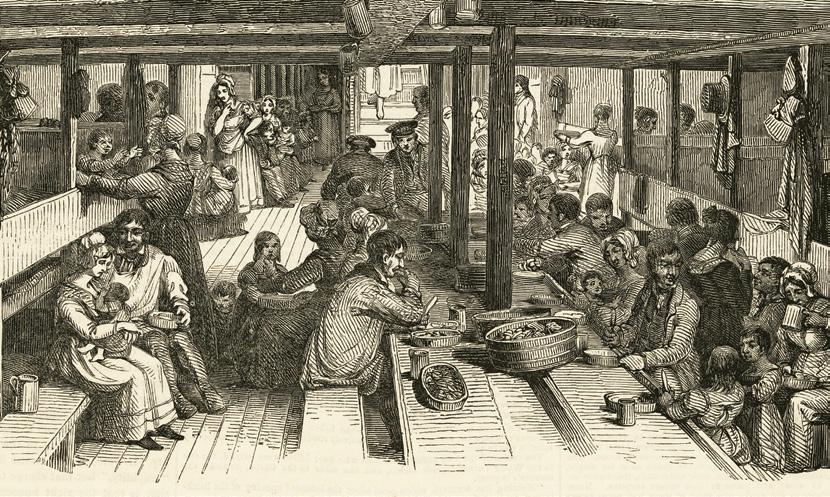
ONE OF THE MANY IRONIES faced by Australia’s convicts was that their labour was both free and unfree. The prisoners transported to Britain’s colonies were captive workers, compelled to toil without payment. Their energies were expended in reshaping occupied Aboriginal country into towns and pastoral runs, benefiting both the colonising process and the fortunes of free emigrants and emancipated convicts alike.
But as the colonial economy expanded, the need for workers outstripped the supply of convicts. By 1831, furthermore, there was increasing disquiet in New South Wales about the proximity of prisoners to polite society. In a desire to attract non-criminal workers to the colony, a range of bounty and assisted passage schemes was introduced. It seemed a neat solution: Britain’s excess proletariat would be encouraged to sail south, forming a grateful, obedient and industrious workforce.
But, as historian Melanie Burkett explains, it didn’t work out that way. Propertied colonists were aghast when funding for the scheme came at the price of an end to land grants. Even before they arrived, therefore, free immigrants were seen as anything but free from expense to what Burkett terms the ‘colonial elite’. What’s more, these landowners, merchants and administrators resented spending wages where once they had been given convict labour.
One result was a rapid and rabid campaign in the colonial press to denigrate the new arrivals. Rather than being welcomed, these workers were described as useless, insolent, entitled and – at worst – immoral.
Their labour was begrudgingly hired, amid accusations that the immigrants were ‘worthless’ detritus from Britain’s bulging poorhouses. While many prior histories have detailed their origins, composition, skills and lifecourse, Opposing Australia’s First Assisted Immigrants focuses on the public discourse about their worth.
Emigrants at dinner on a ship bound for Sydney. Published in the Illustrated London News , 13 April 1844. ANMM Collection 00005628–2. (This image does not appear in the book.)
As a doctoral thesis finessed into a monograph, this book is rich with scholarship and sources, including many maritime documents and diaries. It decries the duality of the ‘elite’ who both prompted assisted immigration and pilloried its bewildered beneficiaries. While Burkett acknowledges that the story is one-sided – given the low literacy levels among many workers – she finds ingenious ways to recover their experiences and protests.
Although comprehensive in scope, the book minimises the place of religious communities in the migration process. Indeed, the critical role of parishes for Britain’s 19th-century poor – and their marked absence in the Australian colonies – could have provided a fascinating chapter.
Nevertheless, this is a valuable source for understanding the social and rhetorical world of New South Wales as convict transportation dwindled and free workers were revalued.

Opposing Australia’s First Assisted Immigrants, 1832–42
By Melanie Burkett, published by Palgrave Macmillan, Cham, Switzerland, 2022. Hardcover, 256 pages, bibliography, index. ISBN 9783030849191
RRP $208.00 Vaughan Evans Library 325.24109940904 BUR
Britain’s excess proletariat would be encouraged to sail south, forming a grateful, obedient and industrious workforce
Reviewer Dr Peter Hobbins is the museum’s Head of Knowledge.

Linda Barwick, Jennifer Green and Petronella Vaarzon-Morel (eds)
Archival Returns: Central Australia and beyond
Call number 069 ARC
Olivier Bernier
The world in 1800
Call number 909.81 BER
Rasa Padgurskis Bertrand
One Australia: The power of a vision
Call number 797.14 BER
Thos Boyles Murray
Pitcairn: The island, the people, and the pastor: to which is added an account of the original settlement and present condition of Norfolk Island
Call number RARE 919.618
DE Bristow
Titanic: Sinking the myths
Call number 910.453 BRI
Harrison Christian
Men Without Country: The true story of exploration and rebellion in the South Seas
Call number 910.453 CHR
Harrison Christian
Should We Fall to Ruin: New Guinea, 1942: The untold true story of a remote garrison and their battle against extraordinary odds
Call number 940.5412 CHR
Donald Clarke (ed)
Ships and Docks
Call number 387.2 SHI
Patrick Connelly and Marten Syme
The Tamar Opportunists: Mahogany Ship mysteries and the Port Fairy adventurers
Call number 910.45309945 CON
Margaret Cook, Lionel Frost, Andrea Gaynor et al
Cities in a Sunburnt Country: Water and the making of urban Australia
Call number 363.6100994 CIT
John Coulter Adventures on the western coast of South America, and the interior of California: including a narrative of incidents at the Kingsmill Islands, New Ireland, New Britain, New Guinea, and other islands in the Pacific Ocean ...
Call number RARE 910.4 COU
Kate Darian-Smith and Paula Hamilton (eds)
Remembering Migration: Oral histories and heritage in Australia
Call number 305.800994 DAR
Megan Davis and George Williams
Everything You Need to Know About the Uluru Statement from The Heart
Call number 323.119915 DAV
Mike Donaldson
Burrup Rock Art: Ancient Aboriginal rock art of Burrup Peninsula and Dampier Archipelago Western Australia
Call number 709.011309941 DON
David Dufty
Radio Girl: The story of the extraordinary Mrs Mac, pioneering engineer and wartime legend Call number 621.3842 DUF
Mick Fanning and Tim Baker
Mick Fanning: Surf for your life Call number 797.32092 BAK
Morris Gleitzman Boy overboard Call number 823.4 GLE
Linda Granfield Pier 21: Gateway of hope Call number 325.716 GRA
Eda Gunaydin
Root & Branch: Essays on inheritance Call number 824.4 GUN
Tom Harrisson
World Within: a Borneo story Call number 959.5400492 HAR
Andrew Hill and Eugenia Hill (eds) All our Working Lives: A project by working people documenting their struggles and achievements Call number 331.88099423 HILL
Roger Hobbs
Indigenous timbers in ship and boat building New South Wales 1820s–1870s Call number 623.844 HOB
David Hunt
Girt Nation: The unauthorised history of Australia Volume 3 Call number 994 HUN
Sovannora Ieng
Surviving Year Zero: My four years under the Khmer Rouge Call number 959.6042 IEN
Achadiati Ikram et al
Inscribing Identity: The development of Indonesian writing systems Call number 499.221 INS
Indigenous Art Centre Alliance Belonging: Stories from far north Queensland Call number 709.943 BEL
Lisa Jardine
Going Dutch: How England plundered Holland’s glory Call number 303.482410492 JAR
Micheline Jenner
The Secret Life of Whales Call number 599.5 JEN
Philip Jones
Ochre and Rust Call number 994.0049915 JON
The Kan-Karroo Kronikle Call number RARE 940.394 KAN
Peter Kemp
The History of Ships Call number 623.82009 KEM
Graeme Kent
Company of Heaven: Early missionaries in the South Seas Call number 266.0230991 KEN
Kenneth Langmaid
The Approaches are Mined! Call number 940.545 LAN
Leah Lui-Chivizhe
Masked Histories: Turtle shell masks and Torres Strait Islander people Call number 391.4349912 LUI
Barrie Macdonald
Essays from the Journal of Pacific History Call number 996 MAC
Duncan McNab
The Ruby Princess Call number 303.485 MCN
Wandjuk Marika Life Story Call number 994.0049915 WAN
AJ Marshall
Darwin and Huxley in Australia Call number 570.994 MAR
Thomas Mayor
Finding the Heart of the Nation: The Journey of the Uluru Statement from the Heart Continues 2nd edition Call number 323.119915 MAY
Ella Mudie
Two Walks Call number 994.41 MUD
Nyunggai Warren Mundine
Speaking my Mind: Common sense answers for Australia Call number 305.89915 MUN
John Pickrell
Flames of Extinction: The race to save Australia’s threatened wildlife Call number 591.630994 PIC
Francis David Reid
The History of the Reid Family: From Scotland to New South Wales Call number 994.002411 REI
Mark C Serreze
Brave New Arctic: The untold story of the melting North Call number 577.276 SER
Ralph Stock
The Cruise of the Dream Ship Call number 910.45 STO
David Stuart
‘The Gaspee affair: from Namquid Point to Botany Bay’ [article in journal The Bridge: A joint edition of the journals of Rhode Island history and Newport history, Spring 2022] Call number 974.502 STU
Dawn Tawse and Alan Hudson (eds) The Guiding Light in Port Stephens Heritage: Nelson Head Inner Lighthouse Call number 994.42 POR
Michael Veitch
Australia’s Secret Army: The story of the coastwatchers, the unsung heroes of Australia’s armed forces during World War II Call number 940.548694 VEI
Emma D Watkins
Life courses of young convicts transported to Van Diemen’s Land Call number 994.02 WAT
Brian Wexham
Shipwrecks of the Western Cape Call number 910.4520968 WEX
ES and CGS Whiteley
HMS Sulphur 1829–1832 Call number 359.3220942 WHI
Lesley William and Tammy Williams
Not Just Back and White: A conversation between a mother and daughter Call number 305.809915 WIL

IN OCTOBER, the Seabin Foundation launched the world’s first Ocean Health Lab to research microplastics in Australia’s waterways. This solar-powered, retrofitted 40-foot shipping container is dedicated to storing, drying, triaging and recording microplastics and other marine litter.
The Australian National Maritime Museum will function as the host venue for the lab and will collaborate with Seabin on educational outreach and programming.
The lab will process material captured from the more than 30 ‘trash skimmer’ Seabin units that the Seabin Project has put into operation in Sydney Harbour since July 2020.
As Pete Ceglinski, Seabin Chief Executive Officer and Founder, says:
Generating ocean health data that will help save our oceans is amazing, and to be starting here in Sydney is simply next level. Sydney is the first city in the world to filter the water 24/7 for microplastics and other harmful contaminants, and now, together, we are benchmarking for the rest of the world to follow suit.
The launch of the Ocean Health Lab is a significant milestone for water quality in Sydney, and a vital asset in Seabin’s ‘100 Smarter Cities for Cleaner Oceans’ campaign, which kicked off in Sydney in July 2020.
To date, this campaign has created six local full-time jobs and filtered over 14 billion litres of water within
Sydney is the first city in the world to filter the water 24/7 for microplastics and other harmful contaminants
The outside of the Ocean Health Lab is decorated with Indigenous art by Bronwen Smith and Gavin Chatfield of Gwiyaala Aboriginal Art, as an invitation to remember our shared connection to waterways and the oceans. Image courtesy Seabin
Sydney Harbour, removing fuel, oil, plastic, microplastics and other harmful contaminants. These include over 73 tonnes of marine litter and more than 4.5 million plastic items (including 1.6 million microplastics).
Staffed by Seabin Foundation’s two full-time marine scientists, the lab functions as a multipurpose research facility and a meeting place where research, citizen science education and community engagement can overlap weekly.
Free tours of the Seabin Ocean Health Lab are available Monday to Friday at 11.30 am and 1.30 pm. Bookings are not required.
For more information, visit seabinproject.com.
The Tasmanian Seafarers’ Memorial at Triabunna jointly commemorates all Tasmanians whose lives were lost at sea, and seafarers of any occupation or origin who lost their lives in Tasmanian waters. Image

THE ‘FLAT SEA’ (Fishers Lost at Sea) Project Group in Western Australia is developing an idea for one or more memorials to pay homage to all fishers who have lost their lives in the commercial fishing industry. The project group is considering creating a memorial trail along the coast of Western Australia that will be connected to a digital online database, similar to the shipwreck trail that currently exists across the state. Several smaller memorials dedicated to such tragedies already exist, some of them in quite remote areas.
The project will be in two stages. Firstly, each catastrophe will be researched in detail and a story written describing its circumstances and legacy, which will then be listed on a website to form part of a virtual or digital memorial. Secondly, a suitable memorial (or memorials) will be erected somewhere on Western Australia’s coastline for people to visit. This is especially relevant in the case of those who perished without a trace and who lack a final resting place where their loved ones can pay their respects.
The Australian Association for Maritime History (AAMH) supports the aims of this group and is seeking to identify how communities around Australia acknowledge the loss of fishers at sea. The AAMH proposes to feature in its newsletter and social media a selection of FLAT Sea memorials and other strategies that commemorate fishers lost at sea. The first to be featured will be the Tasmanian Seafarers’ Memorial at Triabunna, Tasmania. It comprises a physical monument and an online database. The AAMH is also aware of the wonderful work done by Monument Australia in maintaining a database of monuments that include fishers lost at sea: monumentaustralia.org.au .
AAMH Newsletter editor, Peter Ridgway, would like to hear from anyone connected to Fishers Lost at Sea memorials and strategies, and who may be able to assist in preparing future articles for the newsletter. They can contact him via info@aamh.asn.au .
Those seeking more information about the Western Australian FLAT Sea Project should contact Dr James Paratore at fishermemorial@wafic.org.au.
The Australian National Maritime Museum acknowledges the support provided to the museum by all our volunteers, members, sponsors, donors and friends.
The museum particularly acknowledges the following people who have made a significant contribution to the museum in an enduring way or who have made or facilitated significant benefaction to it.
Honorary Fellows
John Mullen AM
Peter Dexter AM
Valerie Taylor AM
Ambassadors
Norman Banham
Christine Sadler
Dr David and Jennie Sutherland
Major Donors
The Sid Faithfull and Christine Sadler
Acquisition Program
David & Jennie Sutherland Foundation
Honorary Research Associates
Rear Admiral Peter Briggs AO
John Dikkenberg
Dr Nigel Erskine
Paul Hundley
Dr Ian MacLeod
Jeffrey Mellefont
David Payne
Lindsey Shaw
Major Benefactors
Margaret Cusack
Basil Jenkins
Dr Keith Jones
RADM Andrew Robertson AO DSC RN
Geoff and Beryl Winter
Honorary Life Members
Yvonne Abadee
Dr Kathy Abbass
Robert Albert AO RFD RD
Bob Allan
Vivian Balmer
Vice Admiral Tim Barrett AO CSC
Lyndl Beard
Maria Bentley
Mark Bethwaite AM
Paul Binsted
Marcus Blackmore AM
David Blackley
John Blanchfield
Alexander Books
Ian Bowie
Colin Boyd
Ron Brown OAM
Paul Bruce
Anthony Buckley OAM
Richard Bunting
Capt Richard Burgess AM
Kevin Byrne
Sue Calwell
RADM David Campbell AM
Marion Carter
Victor Chiang
Robert Clifford AO
Helen Clift
Hon Peter Collins AM QC
Kay Cottee AO
Vice Admiral Russell Crane AO CSM
Stephen Crane
John Cunneen
Laurie Dilks
Dr Nigel Erskine
John Farrell
Dr Kevin Fewster CBE AM FRSA
Bernard Flack
Daina Fletcher
Sally Fletcher
Teresia Fors
CDR Geoff Geraghty AM
John Gibbins
Anthony Gibbs
RADM Stephen Gilmore AM CSC RAN
Paul Gorrick
Lee Graham
Macklan Gridley
VADM Mark Hammond
Sir James Hardy OBE AASA
RADM Simon Harrington AM
Jane Harris
Christopher Harry
Gaye Hart AM
Janita Hercus
Robyn Holt
William Hopkins OAM
Julia Horne
Kieran Hosty
RADM Tony Hunt AO
Marilyn Jenner
John Jeremy AM
Vice Admiral Peter Jones AO DSC
Hon Dr Tricia Kavanagh
John Keelty
Richard Keyes
Kris Klugman OAM
Judy Lee
Matt Lee
David Leigh
Keith Leleu OAM
Andrew Lishmund
James Litten
Hugo Llorens
Tim Lloyd
Ian Mackinder
Stephen Martin
Will Mather
Stuart Mayer
Bruce McDonald AM
Lyn McHale
VADM Jonathan Mead AO
Rob Mundle OAM
Alwyn Murray
Martin Nakata
David O’Connor
Gary Paquet
David Payne
Prof John Penrose AM
Neville Perry
Hon Justice Anthe Philippides
Peter Pigott AM
Len Price
Eda Ritchie AM
John Rothwell AO
Peter Rout
Kay Saunders AM
Kevin Scarce AC CSC RAN
David Scott-Smith
Sergio Sergi
Ann Sherry AO
Ken Sherwell
Shane Simpson AM
Peter John Sinclair AM CSC
Peter R Sinclair AC KStJ (RADM)
John Singleton AM
Brian Skingsley
Eva Skira AM
Bruce Stannard AM
J J Stephens OAM
Michael Stevens
Neville Stevens AO
Frank Talbot AM
Mitchell Turner
Adam Watson
Ian Watt AC
Jeanette Wheildon
Hon Margaret White AO
Mary-Louise Williams AM
Nerolie Withnall
Cecilia Woolford (née Caffrey)
Errata and clarification
An article about The Wharfies Mural appeared in Signals 140 (September 2022). Subsequent research has highlighted some errors.
The full credit for the work and the images is:
The Wharfies’ Mural, 1953–1965, c 1993. Mixed media on plaster, steel. ANMM Collection. Gift from Maritime Union of Australia. All images © Maritime Union of Australia, reproduced with permission.
Notable for the times, three of the nine artists were women – Vi Collings, Evelyn Healy and Pat Kelk Graham. The others were Sonny Glynn, Harry McDonald, Clem Millward, Harry Reade, Ralph Sawyer and Rod Shaw. Rod Shaw, while head of the Wharfies art group, was not a wharfie himself.
Clem Millward’s surname was spelled incorrectly in Signals 140, for which we apologise.




Signals
ISSN 1033-4688
Editor Janine Flew
Staff Photographer Jasmine Poole
Design & production Austen Kaupe
Printed in Australia by Pegasus Media & Logistics
Material from Signals may be reproduced, but only with the editor’s permission.
Editorial and advertising enquiries signals@sea.museum
Not a museum member?
Receive Signals via iSubscribe: www.isubscribe.com.au
Signals back issues
Back issues $4 each or 10 for $30
Extra copies of current issue $4.95 Email thestore@sea.museum
Search all issues at sea.museum/signals
Australian National Maritime Museum 2 Murray Street Sydney NSW 2000 Australia. Phone 02 9298 3777
Our opening hours are:
12 December 2022–29 January 2023: 9.30 am–6 pm (9 pm Fridays from 30 December 2022 to 27 January 2023); 30 January 2023 onwards: 10 am–4 pm (9.30 am–5 pm during NSW school holidays).
The Australian National Maritime Museum is a statutory authority of the Australian Government
Explore Australia’s stories of the sea by becoming a museum member. Options for individuals, families and people who live interstate or overseas offer a great range of benefits, such as unlimited entry to our museum, vessels and exhibitions, as well as special discounts.
Visit sea.museum/members

ANMM Council
Chairman Mr John Mullen AM
Ms Daryl Karp AM
Councillors
Hon Ian Campbell
Mr Stephen Coutts
Hon Justice SC Derrington AM
Rear Admiral Jonathan Earley CSC
Ms Gisele Kapterian
Mr John Longley AM
Mr Nyunggai Warren Mundine AO
Ms Alison Page
Ms Judy Potter
Ms Arlene Tansey
Australian National Maritime Museum Foundation Board
Mr Daniel Janes, Chairman
Mr John Mullen AM, ex officio Chair
Ms Daryl Karp AM, ex officio
Mr David Blackley
Mr Simon Chan
Mr Peter Dexter AM
Mr David Mathlin
Mr Tom O’Donnell
Dr Jeanne-Claude Strong
Ms Arlene Tansey
American Friends of the
Australian National Maritime Museum
Mr Robert Moore II
Mr John Mullen AM
Ms Daryl Karp AM
Signals is printed in Australia on Hannoart Plus Silk 250 gsm (cover) and Hannoart Plus Silk 115 gsm (text) using vegetablebased inks.

Foundation sponsor ANZ
Major sponsors
Commonwealth Superannuation Corporation
Port Authority of New South Wales
Sponsors
Australian Maritime Museums Council
Colin Biggers & Paisley
Gage Roads Brewing Co
Lloyd’s Register
Maritime Union of Australia
Natural History Museum
Nova Systems
Panasonic
Schmidt Ocean Institute
Smit Lamnalco
Tomra
Supporters
Australian Antarctic Division
Australian Government
Pallion
Poulos Bros
Royal Wolf
SBS
Settlement Services International
Silentworld Foundation
Sydney by Sail
@seamuseum_
/sea.museum
#seamuseum
sea.museum/blog

Get set for the summer with our great selection of sun protection gear and handy on-the-go food bags and water bottles.
Eco snack bags
Reduce, reuse, recycle! Check out our range of eco-friendly wraps, bags and other items for home, work lunches and picnics.
RRP $12.95–$39.95 Members $11.65–$35.95
Insulated drink bottles
Forgo the plastic and stay sustainable with your drinks when you’re out and about. We have drink bottles to suit every style and situation.
RRP $34.95–$44.95 Members $31.45–$40.45
Sun hats
Full day of activities ahead? We’ve got you covered. Check out our range of hats and caps – there’s one for every taste.
RRP $49.95–$99.95 Members $44.95–$89.95
Sunscreen
Your skin is precious. Keep it protected and nourished so you can keep living the life you love!
RRP $19.95–$29.95 Members $17.95–$26.95

Open 7 days a week
Email us at theshop@sea.museum Shop online sea.museum/shop
Follow us on Instagram instagram.com/seamuseum_shop

